Samsung Electronics Co SPHL600 Portable Handset with Multi-band GSM/EDGE/WCDMA/CDMA, LTE, WLAN, Bluetooth and RFID User Manual i930 UM
Samsung Electronics Co Ltd Portable Handset with Multi-band GSM/EDGE/WCDMA/CDMA, LTE, WLAN, Bluetooth and RFID i930 UM
Contents
- 1. Users Manual
- 2. Health/Safety/Warrenty Guide
Users Manual

L600
ANDROID SMARTPHONE
User Manual Please
read this manual before operating your phone and
keep it for future reference.
GH68-37765E Printed in Korea

VZW_i930_UM_Eng_xxx_TE_101812_D1
Intellectual Property
All Intellectual Property, as defined below, owned by or which is otherwise the property of Samsung or its respective suppliers
relating to the SAMSUNG Phone, including but not limited to, accessories, parts, or software relating there to (the “Phone
System”), is proprietary to Samsung and protected under federal laws, state laws, and international treaty provisions. Intellectual
Property includes, but is not limited to, inventions (patentable or unpatentable), patents, trade secrets, copyrights, software,
computer programs, and related documentation and other works of authorship. You may not infringe or otherwise violate the
rights secured by the Intellectual Property. Moreover, you agree that you will not (and will not attempt to) modify, prepare
derivative works of, reverse engineer, decompile, disassemble, or otherwise attempt to create source code from the software. No
title to or ownership in the Intellectual Property is transferred to you. All applicable rights of the Intellectual Property shall remain
with SAMSUNG and its suppliers.
Open Source Software
Some software components of this product, including but not limited to 'PowerTOP' and 'e2fsprogs', incorporate source code
covered under GNU General Public License (GPL), GNU Lesser General Public License (LGPL), OpenSSL License, BSD License and
other open source licenses. To obtain the source code covered under the open source licenses, please visit:
http://opensource.samsung.com
.
Disclaimer of Warranties; Exclusion of Liability
EXCEPT AS SET FORTH IN THE EXPRESS WARRANTY CONTAINED ON THE WARRANTY PAGE ENCLOSED WITH THE PRODUCT, THE
PURCHASER TAKES THE PRODUCT "AS IS", AND SAMSUNG MAKES NO EXPRESS OR IMPLIED WARRANTY OF ANY KIND
WHATSOEVER WITH RESPECT TO THE PRODUCT, INCLUDING BUT NOT LIMITED TO THE MERCHANTABILITY OF THE PRODUCT OR
ITS FITNESS FOR ANY PARTICULAR PURPOSE OR USE; THE DESIGN, CONDITION OR QUALITY OF THE PRODUCT; THE
PERFORMANCE OF THE PRODUCT; THE WORKMANSHIP OF THE PRODUCT OR THE COMPONENTS CONTAINED THEREIN; OR
COMPLIANCE OF THE PRODUCT WITH THE REQUIREMENTS OF ANY LAW, RULE, SPECIFICATION OR CONTRACT PERTAINING
DRAFT For Internal Use Only
THERETO. NOTHING CONTAINED IN THE INSTRUCTION MANUAL SHALL BE CONSTRUED TO CREATE AN EXPRESS OR IMPLIED
WARRANTY OF ANY KIND WHATSOEVER WITH RESPECT TO THE PRODUCT. IN ADDITION, SAMSUNG SHALL NOT BE LIABLE FOR
ANY DAMAGES OF ANY KIND RESULTING FROM THE PURCHASE OR USE OF THE PRODUCT OR ARISING FROM THE BREACH OF
THE EXPRESS WARRANTY, INCLUDING INCIDENTAL, SPECIAL OR CONSEQUENTIAL DAMAGES, OR LOSS OF ANTICIPATED PROFITS
OR BENEFITS.
SAMSUNG IS NOT LIABLE FOR PERFORMANCE ISSUES OR INCOMPATIBILITIES CAUSED BY YOUR EDITING OF REGISTRY SETTINGS,
OR YOUR MODIFICATION OF OPERATING SYSTEM SOFTWARE.
USING CUSTOM OPERATING SYSTEM SOFTWARE MAY CAUSE YOUR DEVICE AND APPLICATIONS TO WORK IMPROPERLY. YOUR
CARRIER MAY NOT PERMIT USERS TO DOWNLOAD CERTAIN SOFTWARE, SUCH AS CUSTOM OS. IF YOUR CARRIER PROHIBITS
THIS, IF YOU ATTEMPT TO DOWNLOAD SOFTWARE ONTO THE DEVICE WITHOUT AUTHORIZATION, YOU WILL BE NOTIFIED ON THE
SCREEN THAT THE PHONE WILL NO LONGER OPERATE AND BE INSTRUCTED TO POWER DOWN THE DEVICE. YOU MUST THEN
CONTACT YOUR CARRIER TO RESTORE THE DEVICE TO THE CARRIER-AUTHORIZED SETTINGS.
DRAFT For Internal Use Only

Samsung Telecommunications America (STA), LLC
©2012 Samsung Telecommunications America, LLC. Samsung is a registered trademark of Samsung Electronics Co., Ltd.
Do you have questions about your Samsung Mobile Phone?
For 24 hour information and assistance, we offer a new FAQ/ARS System (Automated Response System) at:
www.samsung.com/us/support
Headquarters:
1301 E. Lookout Drive
Richardson, TX 75082
Customer Care Center:
1000 Klein Rd.
Plano, TX 75074
Toll Free Tel: 1.888.987.HELP (4357)
Internet Address:
http://www.samsung.com
DRAFT For Internal Use Only
The Bluetooth® word mark, figure mark (stylized “B Design”), and combination mark (Bluetooth word mark and “B Design”) are
registered trademarks and are wholly owned by the Bluetooth SIG.
Nuance®, VSuite™, T9® Text Input, and the Nuance logo are trademarks or registered trademarks of Nuance Communications,
Inc., or its affiliates in the United States and/or other countries.
microSD™, microSDHC™ and the microSD logo are Trademarks of the SD Card Association.
Wi-Fi®, the Wi-Fi CERTIFIED logo, and the Wi-Fi logo are registered trademarks of the Wi-Fi Alliance.
LTE is a trademark of ETSI.
Google, Google Play and other marks are trademarks of Google, Inc.
©Samsung Telecommunications America, LLC (“Samsung”). Samsung and Super AMOLED are trademarks of Samsung
Electronics Co., Ltd. and/or its related entities. Other company names, product names and marks mentioned herein are the
property of their respective owners and may be trademarks or registered trademarks. Appearance of device may vary.
©Verizon Wireless. Verizon Wireless and the Verizon Wireless logos are trademarks of Verizon Trademark Services LLC. All
company names, trademarks, logos and copyrights not property of Verizon Wireless are the property of their respective owners.
DRAFT For Internal Use Only

1
Table of Contents
Section 1: Getting Started ...........................5
Understanding this User Manual . . . . . . . . . . . .5
Setting Up Your Phone . . . . . . . . . . . . . . . . . . . .7
Turning the Phone On and Off . . . . . . . . . . . . .11
Setup Wizard . . . . . . . . . . . . . . . . . . . . . . . . . .11
Your Google Account . . . . . . . . . . . . . . . . . . . . 11
Your Samsung Account . . . . . . . . . . . . . . . . . .12
Displaying Your Phone Number . . . . . . . . . . . .12
Voice Mail . . . . . . . . . . . . . . . . . . . . . . . . . . . .12
Guided Tours . . . . . . . . . . . . . . . . . . . . . . . . . .12
Roaming . . . . . . . . . . . . . . . . . . . . . . . . . . . . . 12
TTY Mode . . . . . . . . . . . . . . . . . . . . . . . . . . . .12
Task Manager . . . . . . . . . . . . . . . . . . . . . . . . . 13
Memory Card . . . . . . . . . . . . . . . . . . . . . . . . .13
Securing Your Phone . . . . . . . . . . . . . . . . . . . .14
Section 2: Understanding Your Phone .....16
Features . . . . . . . . . . . . . . . . . . . . . . . . . . . . .16
Front View . . . . . . . . . . . . . . . . . . . . . . . . . . . .17
Side Views . . . . . . . . . . . . . . . . . . . . . . . . . . .18
Back View . . . . . . . . . . . . . . . . . . . . . . . . . . . .19
Home Screen . . . . . . . . . . . . . . . . . . . . . . . . . .20
Navigation . . . . . . . . . . . . . . . . . . . . . . . . . . . .22
Notifications . . . . . . . . . . . . . . . . . . . . . . . . . .26
LED Indicator . . . . . . . . . . . . . . . . . . . . . . . . . .27
Status Bar . . . . . . . . . . . . . . . . . . . . . . . . . . . .27
Primary Shortcuts . . . . . . . . . . . . . . . . . . . . . .30
Widgets . . . . . . . . . . . . . . . . . . . . . . . . . . . . . .30
Shortcuts . . . . . . . . . . . . . . . . . . . . . . . . . . . . .31
Folders . . . . . . . . . . . . . . . . . . . . . . . . . . . . . .31
Wallpaper . . . . . . . . . . . . . . . . . . . . . . . . . . . .32
Apps . . . . . . . . . . . . . . . . . . . . . . . . . . . . . . . .32
Entering Text . . . . . . . . . . . . . . . . . . . . . . . . . .33
Section 3: Contacts and Accounts ...........36
Accounts . . . . . . . . . . . . . . . . . . . . . . . . . . . . .36
Contacts . . . . . . . . . . . . . . . . . . . . . . . . . . . . .38
Speed Dials . . . . . . . . . . . . . . . . . . . . . . . . . . .48
Section 4: Calling ......................................49
Making Calls . . . . . . . . . . . . . . . . . . . . . . . . . .49
DRAFT For Internal Use Only
2
Multi-party Calling . . . . . . . . . . . . . . . . . . . . . 51
Answering Calls . . . . . . . . . . . . . . . . . . . . . . . 52
Ending a Call . . . . . . . . . . . . . . . . . . . . . . . . . 53
Recent Calls . . . . . . . . . . . . . . . . . . . . . . . . . . 53
Call Settings . . . . . . . . . . . . . . . . . . . . . . . . . 55
Section 5: Messaging ............................... 60
Types of Messages . . . . . . . . . . . . . . . . . . . . 60
Text and Multimedia Messaging . . . . . . . . . . . 61
Emergency Alerts . . . . . . . . . . . . . . . . . . . . . . 64
Email . . . . . . . . . . . . . . . . . . . . . . . . . . . . . . . 64
Gmail . . . . . . . . . . . . . . . . . . . . . . . . . . . . . . . 66
Voicemail . . . . . . . . . . . . . . . . . . . . . . . . . . . . 67
Google Talk . . . . . . . . . . . . . . . . . . . . . . . . . . 68
Section 6: Applications ............................ 69
Managing Applications . . . . . . . . . . . . . . . . . . 69
AllShare Play . . . . . . . . . . . . . . . . . . . . . . . . . 71
Amazon Kindle . . . . . . . . . . . . . . . . . . . . . . . . 73
Apps . . . . . . . . . . . . . . . . . . . . . . . . . . . . . . . 73
Backup Assistant+ . . . . . . . . . . . . . . . . . . . . . 73
Calculator . . . . . . . . . . . . . . . . . . . . . . . . . . . 74
Calendar . . . . . . . . . . . . . . . . . . . . . . . . . . . . 74
Camera . . . . . . . . . . . . . . . . . . . . . . . . . . . . . 75
Clock . . . . . . . . . . . . . . . . . . . . . . . . . . . . . . . 81
Color . . . . . . . . . . . . . . . . . . . . . . . . . . . . . . . 81
Contacts . . . . . . . . . . . . . . . . . . . . . . . . . . . . . 82
Downloads . . . . . . . . . . . . . . . . . . . . . . . . . . . 82
Email . . . . . . . . . . . . . . . . . . . . . . . . . . . . . . . 82
Gallery . . . . . . . . . . . . . . . . . . . . . . . . . . . . . . 82
Gmail . . . . . . . . . . . . . . . . . . . . . . . . . . . . . . . 84
Google+ . . . . . . . . . . . . . . . . . . . . . . . . . . . . . 84
Guided Tours . . . . . . . . . . . . . . . . . . . . . . . . . 84
Internet . . . . . . . . . . . . . . . . . . . . . . . . . . . . . 85
Kies Air . . . . . . . . . . . . . . . . . . . . . . . . . . . . . 86
Latitude . . . . . . . . . . . . . . . . . . . . . . . . . . . . . 86
Maps . . . . . . . . . . . . . . . . . . . . . . . . . . . . . . . 87
Media Hub . . . . . . . . . . . . . . . . . . . . . . . . . . . 87
Messaging . . . . . . . . . . . . . . . . . . . . . . . . . . . 88
Messenger . . . . . . . . . . . . . . . . . . . . . . . . . . . 88
Mobile Hotspot . . . . . . . . . . . . . . . . . . . . . . . . 88
Music Hub . . . . . . . . . . . . . . . . . . . . . . . . . . . 88
Music Player . . . . . . . . . . . . . . . . . . . . . . . . . 89
My Files . . . . . . . . . . . . . . . . . . . . . . . . . . . . . 91
My Verizon Mobile . . . . . . . . . . . . . . . . . . . . . 91
Navigation . . . . . . . . . . . . . . . . . . . . . . . . . . . 91
DRAFT For Internal Use Only
3
Phone . . . . . . . . . . . . . . . . . . . . . . . . . . . . . . .92
Local . . . . . . . . . . . . . . . . . . . . . . . . . . . . . . . .92
Play Books . . . . . . . . . . . . . . . . . . . . . . . . . . .92
Play Movies . . . . . . . . . . . . . . . . . . . . . . . . . . .92
Play Music . . . . . . . . . . . . . . . . . . . . . . . . . . .93
Play Store . . . . . . . . . . . . . . . . . . . . . . . . . . . . 93
S Memo . . . . . . . . . . . . . . . . . . . . . . . . . . . . .93
S Suggest . . . . . . . . . . . . . . . . . . . . . . . . . . . .93
S Voice . . . . . . . . . . . . . . . . . . . . . . . . . . . . . .94
Search . . . . . . . . . . . . . . . . . . . . . . . . . . . . . .94
Settings . . . . . . . . . . . . . . . . . . . . . . . . . . . . . .94
Setup Wizard . . . . . . . . . . . . . . . . . . . . . . . . . .95
Talk . . . . . . . . . . . . . . . . . . . . . . . . . . . . . . . . . 95
V CAST Tones . . . . . . . . . . . . . . . . . . . . . . . . . 95
Video Player . . . . . . . . . . . . . . . . . . . . . . . . . .96
Voice Recorder . . . . . . . . . . . . . . . . . . . . . . . .96
Voicemail . . . . . . . . . . . . . . . . . . . . . . . . . . . .97
VPN Client . . . . . . . . . . . . . . . . . . . . . . . . . . . .97
VZ Navigator . . . . . . . . . . . . . . . . . . . . . . . . . .97
YouTube . . . . . . . . . . . . . . . . . . . . . . . . . . . . .97
Section 7: Connections .............................98
Wi-Fi . . . . . . . . . . . . . . . . . . . . . . . . . . . . . . . .98
Wi-Fi Direct . . . . . . . . . . . . . . . . . . . . . . . . . .100
Mobile Hotspot . . . . . . . . . . . . . . . . . . . . . . .101
Bluetooth . . . . . . . . . . . . . . . . . . . . . . . . . . . .102
VPN . . . . . . . . . . . . . . . . . . . . . . . . . . . . . . . .104
Tethering . . . . . . . . . . . . . . . . . . . . . . . . . . . .104
NFC and Beaming . . . . . . . . . . . . . . . . . . . . .105
Android Beam . . . . . . . . . . . . . . . . . . . . . . . .106
S Beam . . . . . . . . . . . . . . . . . . . . . . . . . . . . .106
Nearby devices . . . . . . . . . . . . . . . . . . . . . . .107
Connecting to a Computer . . . . . . . . . . . . . . .108
Connecting to Video Devices . . . . . . . . . . . . .109
Memory Card . . . . . . . . . . . . . . . . . . . . . . . . .109
Section 8: Settings ..................................111
Accessing Settings . . . . . . . . . . . . . . . . . . . .111
Wi-Fi . . . . . . . . . . . . . . . . . . . . . . . . . . . . . . .111
Mobile Hotspot . . . . . . . . . . . . . . . . . . . . . . .113
Bluetooth . . . . . . . . . . . . . . . . . . . . . . . . . . . .115
Data usage . . . . . . . . . . . . . . . . . . . . . . . . . .116
More Wireless and Network Settings . . . . . . .118
Sound . . . . . . . . . . . . . . . . . . . . . . . . . . . . . .124
Display . . . . . . . . . . . . . . . . . . . . . . . . . . . . .128
Wallpaper . . . . . . . . . . . . . . . . . . . . . . . . . . .130
DRAFT For Internal Use Only
4
LED Indicator . . . . . . . . . . . . . . . . . . . . . . . . 131
Motion . . . . . . . . . . . . . . . . . . . . . . . . . . . . . 131
Power saving . . . . . . . . . . . . . . . . . . . . . . . . 132
Storage . . . . . . . . . . . . . . . . . . . . . . . . . . . . 133
Battery . . . . . . . . . . . . . . . . . . . . . . . . . . . . . 134
Application manager . . . . . . . . . . . . . . . . . . 134
Accounts and sync . . . . . . . . . . . . . . . . . . . . 135
Backup Assistant Plus . . . . . . . . . . . . . . . . . 136
Location services . . . . . . . . . . . . . . . . . . . . . 137
Security . . . . . . . . . . . . . . . . . . . . . . . . . . . . 139
Language and input . . . . . . . . . . . . . . . . . . . 145
Back up and reset . . . . . . . . . . . . . . . . . . . . 151
Dock . . . . . . . . . . . . . . . . . . . . . . . . . . . . . . 152
Date and time . . . . . . . . . . . . . . . . . . . . . . . 152
Accessibility . . . . . . . . . . . . . . . . . . . . . . . . . 153
Developer options . . . . . . . . . . . . . . . . . . . . 156
About device . . . . . . . . . . . . . . . . . . . . . . . . 158
Section 9: Health and Safety Information 159
Exposure to Radio Frequency (RF) Signals . . 159
Specific Absorption Rate (SAR) Certification
Information . . . . . . . . . . . . . . . . . . . . . . . . 164
FCC Part 15 Information to User . . . . . . . . . . 165
Commercial Mobile Alerting System (CMAS) . 166
Smart Practices While Driving . . . . . . . . . . . 166
Battery Use and Safety . . . . . . . . . . . . . . . . . 167
Samsung Mobile Products and Recycling . . . 169
UL Certified Travel Charger . . . . . . . . . . . . . . 170
Display / Touch-Screen . . . . . . . . . . . . . . . . 171
GPS . . . . . . . . . . . . . . . . . . . . . . . . . . . . . . . 171
Emergency Calls . . . . . . . . . . . . . . . . . . . . . 172
Care and Maintenance . . . . . . . . . . . . . . . . . 173
Responsible Listening . . . . . . . . . . . . . . . . . 173
Operating Environment . . . . . . . . . . . . . . . . . 176
FCC Hearing Aid Compatibility (HAC) Regulations for
Wireless Devices . . . . . . . . . . . . . . . . . . . . 178
Restricting Children's Access to Your Mobile Device
179
FCC Notice and Cautions . . . . . . . . . . . . . . . 180
Other Important Safety Information . . . . . . . . 180
Section 10: Warranty Information ..........182
Standard Limited Warranty . . . . . . . . . . . . . . 182
End User License Agreement for Software . . 187
Index .........................................................193
DRAFT For Internal Use Only

5
Section 1: Getting Started
Understanding this User Manual
The sections of this manual generally follow the features of
your phone. A robust index for features begins on page 194.
Also included is important safety information beginning on
page 159, that you should know before using your phone.
This manual gives navigation instructions according to the
default display settings. If you select other settings,
navigation steps may be different.
Unless otherwise specified, all instructions in this manual
assume that you are starting from the Home screen. To get to
the Home screen, you may need to unlock the phone. For
more information, see “Securing Your Phone” on page 14.
Note:
Instructions in this manual are based on default settings,
and may vary from your phone, depending on the
software version on your phone, and any changes to the
phone’s Settings.
Unless stated otherwise, instructions in this User Manual
start with the phone unlocked, at the Home screen.
All screen images in this manual are simulated. Actual
displays may vary, depending on the software version of
your phone and any changes to the phone’s Settings.
DRAFT For Internal Use Only

Getting Started 6
Special Text
In this manual, you’ll find text that is set apart from the rest.
These are intended to point out important information, share
quick methods for activating features, to define terms, and
more. The definitions for these methods are as follows:
•
Notes
: Presents alternative options for the current feature or
menu.
•
Tips
: Provides quick or innovative methods, or useful shortcuts.
•
Important
: Points out important information about the current
feature that could affect performance.
•
Warning
: Brings to your attention important information to
prevent loss of data or functionality, or even prevent damage to
your phone.
Text Conventions
This manual provides condensed information about how to
use your phone. To make this possible, the following text
conventions are used to represent frequently-used steps:
➔
Arrows are used to represent the sequence of
selecting successive options in procedures. For
example:
“From the Home screen, touch
Menu
, then
select
Settings
➔
Wi-Fi
.”
Many settings use an On/Off toggle. Touch the
On/Off toggle to turn a setting On or Off. This
graphic is used to represent the On/Off toggle.
DRAFT For Internal Use Only

7
Setting Up Your Phone
Install the 4G LTE SIM (Subscriber Identity Module) card,
battery, and optional memory card, then charge the battery
to begin using your phone.
Back Cover
The battery, SIM card, and optional memory card are
installed under a removable cover on the back of the phone.
Removing the battery cover
Pull up using the slot provided, while lifting the cover
off the phone.
Installing the battery cover
Align the cover and press it firmly into place, making
sure it snaps into place.
Note:
The battery cover is flexible. Take care to avoid bending
or twisting the cover when removing and installing, to
prevent damage to the cover.
DRAFT For Internal Use Only

Getting Started 8
SIM Card
Your phone uses a 4G LTE SIM (Subscriber Identity Module).
The 4G LTE SIM is a small, rectangular plastic card that
stores your phone number, information about your wireless
service, and other information such as messages.
The SIM card is installed under the back cover, and must
remain in the device when in use.
If you purchased your phone at a Verizon Wireless store, the
SIM card is activated and ready to use. If you ordered a new
phone, the card may need to be activated before you can use
it. For more information about activating the SIM card, visit:
http://www.verizonwireless.com/4GSIM
.
Caution!
Turn the phone off before installing or removing the
SIM card. Do not bend or scratch the SIM card. Take
care when handling, installing, or removing the SIM
card, and avoid exposing the SIM card to static
electricity, water, or dirt. Keep the SIM card out of
reach of small children.
Installing the 4G LTE SIM Card
1. Remove the back cover.
2. With the Verizon Wireless logo facing up, carefully
insert the 4G LTE SIM Card into the slot, pressing gently
until it locks into place.
3. Install the back cover.
Removing the 4G LTE SIM Card
1. Turn off the device, then remove the back cover.
2. Press the 4G LTE SIM Card in gently to release the lock,
then carefully slide the 4G LTE SIM Card out of the slot.
3. Install the back cover.
DRAFT For Internal Use Only

9
Battery
Your phone is powered by a rechargeable, standard Li-Ion
battery. A Wall/USB Charger (Charging Head and USB cable)
is included with the phone, for charging the battery.
The battery comes partially charged. You must fully charge
the battery before using your phone for the first time. A fully
discharged battery requires up to 4 hours of charge time.
After the first charge, you can use the phone while charging.
Warning!
Use only Samsung-approved charging devices and
batteries. Samsung accessories are designed to
maximize battery life. Using other accessories may
invalidate your warranty and may cause damage.
Battery Indicator
The battery icon in the Status Bar shows battery power
level. Before the battery becomes too low to operate, the
battery icon flashes and a tone plays. If you continue using
the phone without charging, the phone will power off.
Tip:
Task Manager provides helpful information about
extending battery life. For more information, see “Task
Manager” on page 13.
Installing and Removing the Battery
Installing the battery
1. Remove the battery cover.
2. Insert the battery into the phone, aligning the gold
contacts on the battery with the gold contacts in the
phone.
3. Replace the battery cover.
Removing the Battery
1. Remove the battery cover.
2. Lift the battery up and out of the phone, using the slot
provided.
3. Replace the battery cover.
DRAFT For Internal Use Only

Getting Started 10
Charging the Battery
Your phone comes with a Wall/USB Charger (Charging Head
and USB cable) to charge your phone from any 110/220 VAC
outlet.
Note:
The battery comes partially charged. You must fully
charge the battery before using your phone for the first
time. A fully discharged battery requires up to 4 hours of
charge time. After the first charge, you can use the
phone while charging.
1. Insert the USB cable into the port.
2. Connect the USB cable to the charging head.
3. Plug the charging head into a standard AC power
outlet.
4. When charging is complete, unplug the charging head
from the power outlet and remove the USB cable from
the phone.
DRAFT For Internal Use Only

11
Turning the Phone On and Off
Turning the Phone On
Press and hold the
Power/Lock
Key
until the
phone vibrates and starts up.
Note:
Your phone’s internal antennas are located along the top
and bottom of the phone. Do not block the antennas;
doing so may affect call quality or cause the phone to
operate at a higher power level than is necessary.
Turning the Phone Off
1. Press and hold the
Power/Lock
Key
until the
phone vibrates, and the Device Options menu displays.
2. At the prompt, tap
Power off
.
Setup Wizard
The first time you turn your phone on, Setup Wizard will
guide you through the basics of setting up your phone.
Follow the prompts to choose a default language, set up
accounts, choose location services, and learn more about
your phone.
You can also use the Setup Wizard to quickly configure your
phone at any time.
From the Home screen, touch
Apps
➔
Setup Wizard
.
Your Google Account
Your new phone uses your Google account to fully utilize its
Android features, including Gmail, Google Talk and the Play
Store. When you turn on your phone for the first time, set up
a connection with your existing Google account, or create a
new Google account.
To create a Google account, or set up your Google account on
your phone, use Accounts and sync settings (see “Accounts
and sync” on page 135).
DRAFT For Internal Use Only

Getting Started 12
Your Samsung Account
Create a Samsung account, for access to Samsung apps on
your phone, including Media Hub and AllShare Play. For more
information, see “Accounts and sync” on page 135.
Displaying Your Phone Number
From the Home screen, touch
Menu
, then select
Settings
➔
About device
➔
Status
.
Voice Mail
All unanswered calls to your phone are sent to voicemail,
even if your phone is turned off, so you’ll want to set up your
voicemail and personal greeting as soon as you activate your
phone.
For more information, see “Voicemail” on page 67.
Guided Tours
Get information about using your phone, including videos,
useful tips, and other information.
From the Home screen, touch
Apps
➔
Guided Tours
.
Roaming
When you travel outside your home network’s coverage area,
your phone can use roaming to acquire service on other
compatible digital networks. When roaming, the
Roaming
icon displays in the Status bar.
Tip:
You can set your phone’s roaming behavior. For more
information, see “Mobile networks” on page 123.
During roaming, some services may not be available.
Depending on your coverage area and service plan, extra
charges may apply when making or receiving calls,
connecting to the Internet, or using data services. Contact
Verizon Wireless for more information about your coverage
area and service plan.
TTY Mode
Your phone is TTY-compatible, allowing you to connect a TTY
device to the phone’s headset jack. Before you can use your
phone with a TTY device, you’ll need to enable TTY Mode.
For more information about enabling TTY mode, see “Call
Settings” on page 55.
DRAFT For Internal Use Only

13
Task Manager
Your phone can run apps simultaneously, with some apps
running in the background. Use Task Manager to see which
apps are running on your phone, and to end running apps to
extend battery life. You can also uninstall apps from your
phone and check memory usage.
1. From any unlocked screen, press and hold the
Home Key
, then select
Task manager
.
2. Touch the
Active applications
tab to view apps running
on your phone. Touch
End
, or
End all
to close apps.
3. Touch the
Downloaded
tab to view information about
apps you’ve installed on your phone. Touch
Uninstall
to
remove an app from your phone.
4. Touch the
RAM
tab to display the amount of RAM
(Random Access Memory) in use. Touch
Clear memory
to clear processes to increase available RAM.
5. Touch the
Storage
tab for internal system storage and
SD card memory statistics.
6. Touch the
Help
tab to view information about managing
RAM, and tips for extending battery life.
Tip:
Touch and drag your finger on the tabs to scroll the tabs.
Memory Card
Your phone supports removable microSD™ or microSDHC™
memory cards of up to 64GB capacity, for storage of music,
pictures, and other files.
For more information about using memory cards, see
“Memory Card” on page 109.
DRAFT For Internal Use Only

Getting Started 14
Installing a Memory Card
1. Remove the back cover.
2. With the gold contacts facing down, slide the memory
card into the slot, pushing gently until it locks into
place.
3. Install the back cover.
Removing a Memory Card
Important!
To prevent damage to data stored on the memory
card, unmount the card before removing it from the
phone.
1. From the Home screen, touch
Menu
, then touch
Settings
➔
Storage
➔
Unmount SD card
.
2. At the prompt, read the warning and select
OK
to
continue. Wait for the
SD card safe to remove
icon
to appear in the Status bar and Notification panel.
3. Remove the back cover.
4. Gently press on the memory card to release the lock,
then carefully pull the card out.
5. Install the back cover.
Securing Your Phone
Use your phone’s screen lock features to secure your phone.
Note:
Unless stated otherwise, instructions in this User Manual
start with the phone unlocked, at the Home screen.
To set a personal screen lock, use the Screen lock option
under Security settings. For more information, see “Screen
lock” on page 139.
For other settings related to securing your phone, see
“Security” on page 139.
Locking the phone
By default, the phone locks automatically when the
screen times out.
– or –
Press the
Power/Lock Key
.
Tip:
When the phone is locked, the Emergency call feature is
available on the lock screen, to allow you to make
emergency calls even while the phone is locked.
DRAFT For Internal Use Only

15
Unlocking the phone
Unlock the phone using one of the default unlock screens, or
use Screen lock options for increased security.
Press the
Power/Lock Key
, then touch and
drag your finger across the screen.
Tip:
Special notification icons display for missed calls or new
messages. Drag a missed call or message icon to view
the message or call log.
DRAFT For Internal Use Only

Understanding Your Phone 16
Section 2: Understanding Your Phone
Features
•
4.8-inch 1280x720 HD Super AMOLED
™
touch screen
•
CDMA 1X/EV-DO Rev-A /LTE Wireless Technology
•
1.5 GHz dual-core processor with 2GB RAM
•
Android
®
4.0
•
Google Play
™
Store, plus pre-loaded Google apps
•
SAFE
®
Certified
•
Connections
–
Wi-Fi 802.11 a/b/g/n
–
Mobile Hotspot
–
Bluetooth 4.0
–
Tethering
–
VPN
–
NFC
–
Android Beam
–
S Beam
–
Wi-Fi Direct
–
DLNA
–
USB 2.0
•
Messaging Services
–
Text
–
Picture
–
Video
–
Voice
–
Email
–
Chat
•
8 MP Camera/Camcorder with LED flash + 1.9 MP Front camera
•
Share Shot Camera shooting mode, to quickly share photos via
Wi-Fi Direct
•
Gallery, for viewing and managing pictures and videos
•
S Beam, for easy sharing of large files via NFC
•
Video Player (720p), with Pop Up Play, for watching videos while
multi-tasking with other phone features
•
DivX Certified
®
to play DivX
®
video up to HD 720p, including
premium content
•
Music Player
•
S Voice, for natual voice commands
•
Support for microSD™ and microSDHC™ Memory Cards up to
64GB capacity
DRAFT For Internal Use Only
17
Front View
•
LED Indicator
: Flashes or glows for alerts or phone status. For
more information, see
“LED Indicator”
on page 27.
•
Earpiece
:
Plays sounds.
•
Proximity and Light Sensors
: Detects the presence of objects,
for use with motion settings, and to control the screen display,
such as when you move the phone away from your ear during a
call. Detects ambient light when Automatic brightness is enabled,
and when using the Front camera.
•
1.9 Megapixel Front Camera
: Captures pictures or video.
•
Menu Key
: Touch
to display a context-sensitive menu of options
for the current screen or feature. While using your phone, you
may notice that the Menu Key dims, but it is always available at a
touch to provide a context-sensitive menu for the current screen
or app (you can set the touch key light duration, see page 129).
•
Home Key
: Press to display the Home screen, or Lock screen if
the phone is locked. Press and hold to display recent applications
or launch Task Manager. Press twice from an unlocked screen to
launch S Voice.
•
Back Key
: Touch to return to the previous screen or option. While
using your phone, you may notice that the Back Key dims, but you
can always use it to return to the previous item.
DRAFT For Internal Use Only
Understanding Your Phone 18
Side Views
•
Volume Key
: From the Home screen, press to adjust master
volume. During calls or media playback, press
to adjust volume.
Press to mute the ringtone of an incoming call.
•
Power/Lock Key
: Press and hold to turn the phone on or off, and
to access a device options menu. Press to lock the phone, or to
wake the screen for unlocking.
DRAFT For Internal Use Only
19
Back View
•
LED Flash
: Use when taking photos or recording video.
•
Microphones (top and bottom)
: Capture audio during recording,
during phone calls, and video chat.
•
8 Megapixel Camera
: Use when taking photos or recording
videos.
•
3.5mm Headset Jack
: Plug in an optional headset or TTY
equipment.
•
Speaker
: Play ringtones, call audio when in Speakerphone mode,
music and media playback, and other sounds.
•
USB/Accessory Port
: Connect a USB cable for charging or to
sync music and files.
DRAFT For Internal Use Only

Understanding Your Phone 20
Home Screen
The Home screen is the starting point for using your phone.
•
Status Bar
: Presents icons to show network status, battery
power, and connection details. For a list of icons, see
“Status
Bar”
on page 27.
•
Primary Shortcuts
: Shortcuts to your phone’s common apps. For
more information, see
“Primary Shortcuts”
on page 30.
•
Shortcuts
: Shortcuts to apps.These shortcuts are found on the
Home screen by default, and you can add more shortcuts to your
favorite apps. For more information, see
“Shortcuts”
on
page 31.
•
Widgets
: Apps that run on the Home screen. These widgets are
found on the Home screen by default, and you can add your
favorites. For more information, see
“Widgets”
on page 30.
Note:
Unless stated otherwise, instructions in this User Manual
start with the phone unlocked, at the Home screen.
All screen images in this manual are simulated. Actual
displays may vary, depending on the software version of
your phone and any changes to the phone’s Settings.
DRAFT For Internal Use Only

21
Extended Home Screen
The Home screen consists of the Home panel, plus panels
that extend beyond the display width to provide more space
for adding shortcuts, widgets and folders.
Slide your finger horizontally across the screen to scroll to
the left or right side panels. As you scroll, the indicator at the
bottom of the display shows your current position.
Customizing the Home Screen
Customize the Home screen to suit your preferences.
•
Add App Shortcuts
: For more information, see
“Shortcuts”
on
page 31.
•
Add Widgets
: For more information, see
“Widgets”
on page 30.
•
Add Folders
: For more information, see
“Folders”
on page 31.
•
Change the Wallpaper
: For more information, see
“Wallpaper”
on page 32.
•
Display settings
: For more information, see
“Display”
on
page 128.
Adding and removing Home screen panels
Your phone comes with 7 Home screen panels. You can
customize the Home screen to include up to the seven
default panels, and set one panel as Home.
1. From the Home screen, touch
Menu
, then touch
Edit
.
2. Slide your finger across the screen to scroll the panels,
and use these controls to configure panels:
Tip:
You can also “pinch” the Home screen to display Edit
options.
Remove
: Touch and hold on a panel, then drag it
to
Remove
.
Add
: Touch a previously-removed panel to add it,
up to the default total of seven.
Set as Home
: Touch to assign a panel as the Home
screen. The panel set as Home will display when
you press the
Home Key
.
DRAFT For Internal Use Only

Understanding Your Phone 22
Navigation
Navigate your phone’s features using the command keys and
the touch screen.
Warning!
Please note that a touch screen responds best to a
light touch from the pad of your finger or a non-
metallic stylus. Using excessive force or a metallic
object when pressing on the touch screen may
damage the tempered glass surface and void the
warranty. For more information, see “Warranty
Information” on page 182.
Context-sensitive Menus
While using your phone, context-sensitive menus offer
options for the feature or screen.
To access context-sensitive menus:
•
Touch
Menu
.
•
Touch and hold on an item.
Finger Gestures
Touch
Touch items to select or launch them. For example:
•
Touch the onscreen keyboard to enter characters or text.
•
Touch an item to select it.
•
Touch an app’s icon to launch the application.
Touch and Hold
Activate items by a touch and hold gesture. For example:
•
Touch and hold a widget on the Home screen to move it.
•
Touch and hold on a field to display a pop-up menu of options.
Swipe
Swipe your finger across the screen. For example:
•
Unlocking the screen
•
Scrolling the Home screen or a menu
•
Combine touch and hold with swipe to drag an item.
Pinch
Using two fingers, make a pinch motion on the screen. For
example:
•
Pinch in to zoom in on pictures or screens.
•
Pinch out to zoom out on pictures or screens.
DRAFT For Internal Use Only
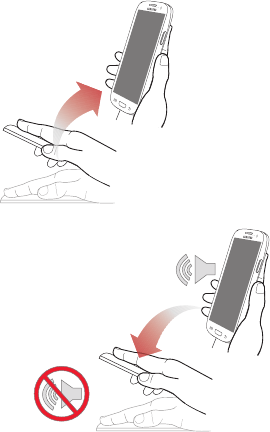
23
Hand Gestures
Your phone recognizes motion, to allow you to navigate and
access features by moving the phone in specific gestures.
To use gestures, enable the Motion settings. For more
information, see “Motion” on page 131.
Pick Up or Turn Over
Lift the phone, or place the phone screen-down, on a
horizontal surface, such as a table.
•
Direct call
: When this setting is On, you can lift the phone to your
ear to call a displayed contact in Messaging, Contacts, or Call Log
to dial the contact’s phone number.
•
Smart alert
: When this setting is On, the phone will automatically
notify you to missed calls and alerts that occurred while the
phone was stationary.
•
Turn over to mute/pause
: When this setting is On, turning the
phone screen-down automatically mutes incoming call ringtones
and alerts sounds.
DRAFT For Internal Use Only
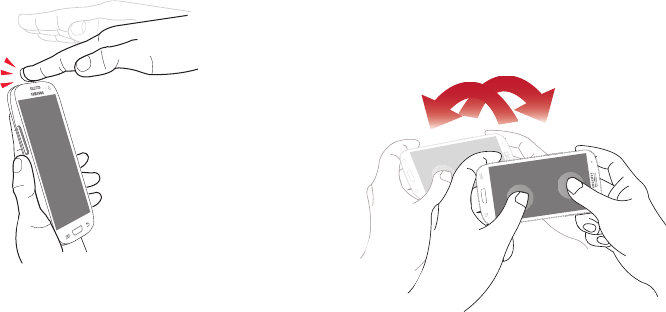
Understanding Your Phone 24
Tap to top
Tap on the top of the phone twice, quickly.
•
Tap to top
: When this setting is On, a double tap on the top of the
phone takes you to the top of a list.
Tilt
Touch and hold with your thumbs on the screen, then tilt the
phone forward and back to zoom in or out.
•
Tilt to zoom
: When this setting is On, tilting the phone while in
Gallery or Internet causes the screen to zoom in or out.
DRAFT For Internal Use Only
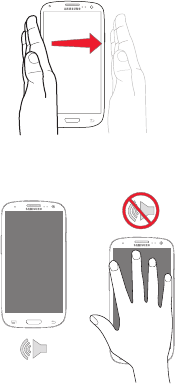
25
Pan
Touch and hold on the screen, then move the phone in a
side-to-side motion.
•
Pan to move icon
: When this setting is On, moving the phone in a
panning motion (side-to-side) moves a highlighted icon to a new
location on the Home screen.
•
Pan to browse images
: When this setting is On, moving the phone
in a panning motion while viewing an image moves focus around
in the image.
Shake
Shake your phone to scan for nearby devices, such as
Bluetooth or Kies air devices, and more, for connecting to
your phone for sharing files.
•
Shake to update
: When this setting is On, shaking the phone
starts a scan for nearby devices for sharing.
Palm
Use your hand to swipe across the screen, or cover the
screen.
•
Palm swipe to capture
:
When this setting is On,
swiping the screen with the
side of your hand (left to
right, or right to left)
captures a screen shot.
•
Palm touch to mute/pause
:
When this setting is On,
covering the screen with
your hand mutes or pauses
media playback.
DRAFT For Internal Use Only
Understanding Your Phone 26
Notifications
Notifications shows information about connections, alerts
and other items.
1. Touch and drag downward
from the top of the screen to
display notifications.
2. Touch an item to open the
item, or to launch the
related app or feature.
World Clock
While displaying Notifications,
touch the time in the Status bar to
display a World clock. Add cities
to the clock to display the time in
different zones around the world.
Clearing Notifications
1. Sweep your finger downward from the top of the
screen to display Notifications.
2. Touch a notification to clear it, or touch
Clear
to clear all
notifications.
Settings
Use settings at the top of Notifications to control popular
settings. Slide your finger right and left to see all the icons.
•
Bluetooth
: Turn Bluetooth On or Off. See
“Bluetooth”
on
page 102.
•
GPS
: Turn Standalone GPS services on or off. See
“Standalone
GPS services”
on page 138.
•
Sound
: Switch between sound settings, and the two Silent
modes, Mute and Vibrate. See
“Silent mode”
on page 124.
•
Mobile data
: Activate or deactivate your phone’s access to
mobile data service. See
“Turning Mobile data On or Off”
on
page 116.
•
Screen rotation
: Enable or disable the Auto rotation setting, to
control whether the screen automatically updates when you
rotate the phone. See
“Auto-rotate screen”
on page 129.
•
Power saving
: Enable or disable Power saving mode. See
“Power saving”
on page 132.
•
Airplane mode
: Turn Airplane mode On or Off. See
“Airplane
mode”
on page 118.
DRAFT For Internal Use Only

27
•
Driving mode
: Enable or disable Driving mode, to have incoming
caller ID and text messages read out. See
“Text-to-speech
output”
on page 150.
•
Sync
: Enable or disable synchronization with your accounts. See
“Sync”
on page 135.
LED Indicator
The LED indicator , on the front of the phone above the
screen (see “Front View” on page 17) animates or glows to
show alerts or phone status.
•
Blue:
–
Pulses in multi-color blue while the phone is turning On or Off.
–
Blinks blue for a missed call, message or other notification.
•
Red:
–
Glows red when the phone is connected to a charger and
charging.
–
Blinks red when the phone is connected to a charger and there
is a problem with charging.
–
Blinks red when battery power is low (phone not connected to
charger).
•
Green:
–
Glows green when the phone is connected to a charger and the
battery is fully charged.
Status Bar
The Status Bar shows network and battery status and other
details, including these common icons.
Airplane Mode Active
: All wireless
communications are disabled. See “Airplane
mode” on page 118.
USB Connected
: The phone is connected to a
computer using a USB cable. For more information
about transferring data between your phone and
a computer, see “Transferring Data” on page 108.
Voice Call
: A voice call is in progress.
Speakerphone
: Speakerphone is enabled.
Missed Call
: Displays when there is a missed call.
Mute
: Voice or playback volume is muted.
Battery Level
: Shown fully charged.
Battery Charging
: Battery is charging.
Device Power Critical
: Battery has very little power
remaining. Charge immediately.
DRAFT For Internal Use Only

Understanding Your Phone 28
GPS E911 Only
: E911 location is active (cannot be
turned off). See “E911” on page 137.
GPS Location Active
: One or more GPS location
services are active. See “Location services” on
page 137.
Missing SIM
: No SIM is installed.
No Network
: No wireless network is available.
3G connection
: Phone is active on a 3G system. The
arrows are colored when data is being
transferred.
4G LTE Connection
: Phone is active on a 4G LTE
system. The arrows are colored when data is
being transferred.
Signal Strength
: Current signal strength. The
greater the number of bars, the stronger the
signal.
Signal Strength Roaming, Open
: Current signal
strength, when the phone is roaming. The greater
the number of bars, the stronger the signal.
R
Signal Strength Roaming, CDMA
: Current signal
strength, when the phone is roaming on CDMA
networks. The greater the number of bars, the
stronger the signal.
Wi-Fi Active
: Wi-Fi is active, and connected to a
Wi-Fi network. The greater the number of rays,
the stronger the signal. The arrows are colored
when data is being transferred. For more
information about configuring Wi-Fi, see “Wi-Fi”
on page 98.
Wi-Fi Action Needed
: Action needed to connect to
Wi-Fi network. For more information about
configuring Wi-Fi, see “Wi-Fi” on page 98.
New Message
: You have new message(s).
New Voicemail
: You have new voicemail. A
number indicates the number of new messages.
New Email Message
: You have new email.
Download Successful
: A file was downloaded
successfully.
DRAFT For Internal Use Only

29
Update Available
: An update is available for an
installed app.
Update Successful
: An update was installed for an
app.
Alarm
: An alarm is set.
Silent mode
: All sounds except media and alarms
are silenced, and Vibrate is not active. See “Silent
mode” on page 124.
Vibrate
: Vibrate Silent mode is active. See “Silent
mode” on page 124.
Music Playing
: Music is playing, but the app is in
the background. You can control playback from
Notifications, or from Music player.
Music Paused: Music playback is paused. You can
control playback from Notifications, or from Music
player.
SD Card Ready
: A memory card scan is underway,
to prepare the card for use. For more information
about using memory cards, see “Memory Card”
on page 109.
SD Card Safe to Remove
: A memory card was
unmounted, and it is safe to uninstall it. For more
information about using memory cards, see
“Memory Card” on page 109.
SD Card Removed
: A memory card was
uninstalled. For more information about using
memory cards, see “Memory Card” on page 109.
Bluetooth Active
: Bluetooth is turned on. For more
information, see “Turning Bluetooth On or Off” on
page 103.
Bluetooth Paired
: Your device is paired with
another Bluetooth device. For more information,
see “Pairing with a Bluetooth Device” on
page 103.
TTY
: TTY Mode is active.
ECB
: Emergency Call Back Mode is active.
DRAFT For Internal Use Only

Understanding Your Phone 30
Primary Shortcuts
Primary Shortcuts appear at the bottom of the display. You
can edit the Primary Shortcuts, except for
Apps
.
Editing the Primary Shortcuts
To add or remove shortcuts:
Touch and hold a shortcut, then drag it from the
Primary Shortcuts to the Home screen, or from the
Home screen to the Primary Shortcuts.
To remove shortcuts:
Touch and hold the shortcut until
Remove
appears,
then drag the shortcut to the
Remove
icon.
Widgets
Widgets are self-contained applications that you can place
on the Home screen for quick access.
Adding Widgets to the Home screen
Adding widgets from the Home screen
1. Navigate to a Home screen panel, then touch and hold
on the screen to display the
Home
screen
menu.
2. Touch
Add to Home screen
, then select
Apps
.
3. Touch the
Widgets
tab, then touch a widget and follow
the prompts to configure the widget and place it on the
Home screen.
Adding Shortcuts from Widgets
1. Navigate to a Home screen panel.
2. Touch
Apps
, then touch the
Widgets
tab.
3. Touch a widget, then follow the prompts to configure
the widget and place it on the Home screen.
Removing Widgets
Touch and hold the widget until
Delete
appears,
then drag the widget to the
Delete
icon.
DRAFT For Internal Use Only

31
Shortcuts
Use App shortcuts for quick access to applications from the
Home screen. Your phone comes with app shortcuts already
placed on the Home screen, and you can add your favorites.
Adding Shortcuts to the Home Screen
Adding shortcuts from the Home screen
1. Navigate to a Home screen panel, then touch and hold
on the screen to display the
Add to Home
screen
menu.
2. Touch
Add to Home screen
, then touch
Apps
.
3. Touch an app, then follow the prompts to configure the
shortcut and add it to the Home screen
Adding Shortcuts from Apps
1. Navigate to a Home screen panel.
2. Touch
Apps
.
3. Touch and hold on an app until it appears on the Home
screen.
Removing Shortcuts
Touch and hold the shortcut until
Remove
appears,
then drag the shortcut to the Remove icon.
Folders
Place folders on the Home screen to organize items.
Adding Folders
1. Navigate to a Home screen panel, then touch and hold
on the screen to display the
Home
screen
menu
2. Select
Add to Home screen
, then touch
Folder
.
3. The folder displays on the Home screen. Touch the
folder to name it.
Removing Folders
Touch and hold the folder until
Remove
appears,
then drag the folder to the Remove icon.
DRAFT For Internal Use Only

Understanding Your Phone 32
Wallpaper
Choose a picture to display in the background of the Home
screen. You can choose from pre-loaded wallpaper images,
or select a picture you’ve taken with the Camera or
downloaded.
1. From the Home screen, touch and hold on the screen
to display the
Home
screen
menu, then select
Home
screen
,
Lock screen
, or
Home and lock screen
.
2. Choose a source:
•Gallery
: Choose a picture stored on your phone or on an
optional installed memory card. Touch a picture to select it,
then use the crop tool to resize the picture, if desired. Touch
Done
to set the picture as wallpaper.
• Live wallpapers
: Choose from pre-loaded interactive moving
wallpapers. Touch a wallpaper, then touch
Set wallpaper
.
• Wallpaper
: Choose from pre-loaded wallpaper images. Touch
a wallpaper, then touch
Set wallpaper
.
Note:
You can also set Wallpaper in Settings. For more
information, see “Wallpaper” on page 130.
Apps
Apps holds all applications installed on your phone.
Applications that you download and install are also added to
Apps.
The Apps screen is like the Home screen, it consists of
panels that extend beyond the display width to provide more
space. Slide your finger horizontally across the screen to
scroll to the left or right side panels. As you scroll, the
indicator at the bottom of the display shows your current
position.
For more information about applications, see “Applications”
on page 68.
You can place shortcuts to apps on the Home screen, for
quick access to the app. For more information, see “Adding
Shortcuts from Apps” on page 31.
1. From the Home screen, touch
Apps
.
2. Slide your finger left or right to scroll the Apps screens.
3. Touch an icon to launch the application.
DRAFT For Internal Use Only

33
Entering Text
Your phone uses a virtual QWERTY keyboard for text entry.
Use the keyboard to enter letters, punctuation, numbers, and
other characters into text entry fields or applications. Access
the keyboard by touching any text entry field.
You can also use voice input to speak your inputs.
The virtual QWERTY keyboard displays at the bottom of the
screen. By default, when you rotate the phone, the screen
orientation updates to display the keyboard at the bottom of
the screen.
Text Input Methods
Your phone offers two text input methods, Samsung
keyboard and Google voice typing.
You can set a default text entry method in Settings. For more
information, see “Keyboards and input methods” on
page 146.
To choose a text input method at any time:
While entering text, touch and drag downward from the
top of the screen to display Notifications, then touch
Select input method
.
Using Samsung Keyboard
The Samsung keyboard is a custom virtual QWERTY
keyboard, featuring optional predictive text. Input characters
by tapping the on-screen keys with your finger, or use
speech recognition.
You can enable predictive text, to have the Samsung
keyboard match your key touches to common words and
displays them. Select a word from the display to insert it into
your text.
Configuring Samsung keyboard
Configure the Samsung keyboard to your preferences.
•
For more information, see
“Samsung keyboard”
on page 147.
•
While entering text, touch , then select from the pop-up
menu.
DRAFT For Internal Use Only

Understanding Your Phone 34
Entering Upper and Lower Case Letters
The default case is lower case (abc). Enter upper and lower
case alphabet letters by touching the Shift key to toggle the
case, before touching the letter key(s).
•
Touch once to switch from abc to Abc mode
•
Touch and hold to switch to ABC mode
Entering Symbols and Numbers
To enter common symbols, touch to switch to symbol
mode, then touch the corresponding key.
To enter less-common symbols, touch
➔
, then
touch the corresponding key.
Enter numbers by touching , then touching the number
keys.
Using Google Voice Typing from the Samsung
keyboard
When you enable the Voice input setting for Samsung
keyboard, you can access Google Voice Typing from the
Samsung keyboard.
For more information about enabling Voice input, see
“Samsung keyboard” on page 147.
Touch , then speak your input.
DRAFT For Internal Use Only

35
Using Predictive text
By using Predictive text, you can have next-letter prediction
and regional error correction, which compensates for
pressing the wrong keys on the QWERTY keyboard.
Note:
Enable Predictive text in Samsung keyboard settings, to
have the Voice Input appear on the keyboard. For more
information, see “Samsung keyboard” on page 147.
While entering characters, potential word matches
display in the Predictive text area above the keyboard.
Touch a word to insert it into your text.
Using Google Voice Typing
Use your voice to enter text using the Google Voice typing
feature.
1. While entering text, touch and drag downward from the
top of the screen to display Notifications, then touch
Select input method
➔
Google voice typing
.
2. At the
Listening
prompt, speak your text. As you speak,
the text is displayed in the text field.
DRAFT For Internal Use Only

Contacts and Accounts 36
Section 3: Contacts and Accounts
Accounts
Your phone provides the ability to synchronize information,
from a variety of accounts, including Email, Facebook,
Google, and your Samsung account. Depending on the
account, you can choose to synchronize your calendar,
contacts, and other types of content.
Contacts from your accounts appear in your phone’s
Contacts.
With synchronization, you can ensure that information on
your phone is updated with any information that changes in
your accounts.
Controlling Synchronization
You can choose to have your phone automatically sync with
your accounts, or manually synchronize each account when
you want to check messages.
You may also choose to limit automatic or background
synchronization to extend battery life.
1. From the Home screen, touch
Menu
, then touch
Settings
➔
Accounts and sync
.
2. At the top of the screen, touch to control
synchronization. Choose
ON
to allow synchronization
automatically, at any time, or choose
OFF
. When set to
OFF, you can manually sync accounts with the Sync
option available in the accounts.
Tip:
You can also control synchronization from Notifications,
with the Sync toggle. For more information, see
“Notifications” on page 26.
DRAFT For Internal Use Only

37
Setting Up Your Accounts
Set up and manage your accounts with the Accounts and
sync settings.
For information about setting up other, non-synchronized
email accounts, see “Setting Up Email Accounts” on
page 64.
Tip:
For more information on setting up your email, visit the
Smartphone Resource Center at:
https://smartphones.verizonwireless.com
Adding an account
1. From the Home screen, touch
Menu
, then touch
Settings
➔
Accounts and sync
➔
Add account
.
2. Select an account provider, then follow the prompts to
enter your credentials and sign in.
3. The phone communicates with the provider’s server to
set up your account on the phone.
Managing accounts
1. From the Home screen, touch
Menu
, then touch
Settings
➔
Accounts and sync
.
2. Select an account, then touch a setting to enable or
disable synchronization. When enabled, a check mark
appears in the check box.
DRAFT For Internal Use Only

Contacts and Accounts 38
Contacts
Use Contacts to store information for your friends, family and
colleagues, to make contacting them easy.
To access Contacts:
From the Home screen, touch
Contacts
.
Contact tips:
•
Swipe your finger left-to-right across a contact to make a call to
the contact.
•
Swipe right-to-left across a contact to create a message
addressed to the contact.
Creating Contacts
1. From the Home screen, touch
Contacts
➔
Create contact
.
2. At the
Save contact to
prompt, select a save option for
the contact (options depend on accounts set up):
• Phone
: Save to the phone’s Contacts.
• Google
: Save to your Google account.
•Corporate
: Save to your Corporate account.
3. Touch contact fields to enter information:
•
Touch
Photo ID
to choose a picture to identify the contact.
•
Touch
Name
to enter a name for the contact. Touch to
enter
Name prefix
,
First
name
,
Middle name
,
Last name,
or
Name suffix
.
•
Touch
Phone number
to enter a phone number, then touch the
Label
button to choose a label, from
Mobile
,
Home
,
Work
,
Work Fax
,
Home Fax
,
Pager
,
Other
,
Custom
or
Callback
. To
add another number, touch .
•
Touch
Email address
to enter an email address, then touch the
Label
button to choose a label, from
Home
,
Work
,
Other
, or
Custom
to create a new label. To add an address, touch .
DRAFT For Internal Use Only

39
•
Touch
Address
to enter an email address, then touch the
Label
button to choose a label, from
Home
,
Work
,
Other
, or
Custom
to create a new label. To add an address, touch .
•
Touch next to
Events
to enter a special date, then touch
the
Label
button to choose a label, from
Birthday
,
Anniversary
,
Other
, or
Custom
to create a new label.
•
Touch
Groups
to assign the contact to a group. For more
information about Groups, see
“Groups”
on page 46.
•
Touch
Ringtone
to choose a ringtone for the contact.
•
Touch
Vibration pattern
to choose a vibration pattern to play
along with the ringtone when this contact calls or sends you a
message.
•
Touch
Add another field
to add more fields, including
Phonetic Name
,
Organization
,
IM
,
Notes
,
Nickname
,
Website
, or
Relationship
.
4. When you finish entering information, touch
Save
.
Creating Contacts from Recent calls
Save a phone number from a recent call to create a new
contact, or update an existing contact.
For more information, see “Creating or Updating Contacts
Using Recent calls” on page 54.
Creating Contacts from the Phone Keypad
Enter a phone number with the Phone Keypad, then save it.
1. From the Home screen, touch
Phone
.
2. Touch the digits of the phone number on the
Keypad
.
3. Touch
Add to Contacts
, then select
Create contact
from
the pop-up menu.
4. Continue entering contact information. For more
information, see “Creating Contacts” on page 38.
Tip:
While entering a phone number, you can add waits or
pauses. Enter the number up to the pause or wait, then
touch
Menu
to select
Add 2 sec pause
or
Add wait
.
DRAFT For Internal Use Only

Contacts and Accounts 40
Updating Contacts
Make changes to update an existing contact.
1. From the Home screen, touch
Contacts
.
2. Touch a contact to view its information, then touch
Edit
.
– or –
Touch and hold a contact, then select
Edit
from the
menu.
3. Continue entering contact information. For more
information, see “Creating Contacts” on page 38.
Updating Contacts from the Phone Keypad
Enter a phone number with the Phone Keypad, then save it.
1. From the Home screen, touch
Phone
.
2. Touch the digits of the phone number on the
Keypad
.
3. Touch
Add to Contacts
, then select
Update existing
from
the pop-up menu.
4. Select a contact to update, then continue entering
contact information. For more information, see
“Creating Contacts” on page 38.
Updating Contacts from Recent calls
Save a phone number from a recent call to create a new
contact, or update an existing contact.
For more information, see “Creating or Updating Contacts
Using Recent calls” on page 54.
DRAFT For Internal Use Only

41
Choosing Contacts to Display
1. From the Home screen, touch
Contacts
.
2. Touch
Menu
, then touch
Contacts to display
:
•
Choose
All contacts
to show all contacts.
•
Choose an account to only display contacts from that account.
•
Touch
Phone
to show only show contacts saved to the phone.
•
Choose
Customized list
to select contact types for each
account, or the phone.
Contacts Settings
1. From the Home screen, touch
Contacts
.
2. Touch
Menu
, then touch
Settings
:
•
Select
Only contacts with phones
to show contacts with at
least one stored phone number.
•
Touch
List by
to sort contacts by first or last name.
•
Touch
Display contacts by
to list contacts by first or last name.
•
Touch
Send contact
to set your preference for transferring
contacts by Bluetooth contacts. For more information about
sending contacts, see
“Sending Namecards (vCards)”
on
page 44.
Other Contacts Options
1. From the Home screen, touch
Contacts
.
2. Touch a contact to display it, then touch
Menu
:
•History
: View calls and messages to and from this contact.
•Edit
: Modify contact information. For more information, see
“Updating Contacts”
on page 40.
•Delete
: Erase the contact record.
• Join contact/Separate contact
: Manage multiple contacts as
one. For information, see
“Joining Contacts”
on page 42.
• Mark as default
: Set a default phone number or other field
(such as IM or email address). Defaults are the contact method
used when creating a message or calling a contact. You can
also set a default by touching and holding on a contact field.
• Share namecard via
: Send the namecard. For information,
see
“Sending Namecards (vCards)”
on page 44.
• Add to reject list
: Mark the contact so that calls or messages
from the contact are rejected automatically. To remove a
contact form the reject list, touch and hold on the contact in the
main contacts screen, then choose
Remove from reject list
.
• Print namecard
: Print the namecard via Bluetooth to a
compatible Samsung Bluetooth-enabled printer.
DRAFT For Internal Use Only

Contacts and Accounts 42
My Local Profile
My local profile is your own contact record, listed under ME
in Contacts. You can send My local profile as a vCard via
Bluetooth or as an attachment.
Creating My Local Profile
1. From the Home screen, touch
Contacts
.
2. Touch
Set up profile
, then enter your information
in the
contact fields.
For more information, see “Creating
Contacts” on page 38.
Sending My Local Profile
You can send your profile as a vCard via Bluetooth to other
Bluetooth devices, or as an attachment.
1. From the Home screen, touch
Contacts
.
2. Touch your profile to display your contact information.
3. Touch
Menu
, then touch
Share namecard via
.
4. Choose a sending method, then follow the prompts to
send the profile.
Joining Contacts
Your phone can synchronize with multiple accounts,
including Google, Corporate, and other providers, plus social
networking sites like Facebook. When you synchronize
contacts from these accounts with your phone, you may have
multiple contacts for one person.
Joining contact records allows you to see all the contact’s
numbers and addresses together. Joining also helps you
keep your contacts updated, because any changes to
information in the respective accounts is automatically
updated the next time you synchronize with the account.
Joining contacts
1. From the Home screen, touch
Contacts
.
2. Touch and hold on a contact, then select
Join contact
.
3. Select a contact to join to the selected contact.
DRAFT For Internal Use Only

43
Separating contacts
1. From the Home screen, touch
Contacts
.
2. Touch a contact to display its information.
3. Under the
Connection
heading, phone icons show how
many contacts are joined to this one. Touch the
Connection
field to display joined contacts.
4. Touch next to a contact to remove it from the
displayed contact.
Exporting and Importing Contacts
You can export your contact list to and from USB storage
(your phone’s memory), or an installed memory card.
Contacts are exported and imported as a special VCF file, and
contacts are sent as vCards.
1. From the Home screen, touch
Contacts
.
2. Touch
Menu
, then touch
Import/Export
.
3. Select an option, then follow the prompts to complete
the operation:
• Import from USB storage
: Copy contacts that are saved in
phone memory.
• Export to USB storage
: Copy contacts to phone memory.
• Import from SD card
: Copy contacts from an installed memory
card.
• Export to SD card
: Copy contacts to an installed memory card.
• Send namecard via
: Share contacts as vCards. For more
information, see
“Sending Namecards (vCards)”
on
page 44.
DRAFT For Internal Use Only

Contacts and Accounts 44
Sending Namecards (vCards)
You can send a contact namecard as a vCards via Bluetooth
to other Bluetooth devices, or as an attachment via Gmail or
Email.
Important!
Not all Bluetooth devices will accept contacts, and
not all devices support transfers of multiple
contacts. Check the target device’s documentation.
1. From the Home screen, touch
Contacts
.
2. Touch
Menu
, then touch
Import/Export
➔
Send
namecard via
.
3. Touch contacts to mark them for sending, or touch
Select all
to mark all contacts. A check mark appears in
the check box for marked contacts.
4. Touch
Done
. At the prompt, choose a sending method,
then follow the prompts to send the namecard:
• Bluetooth
: For more information about sending via Bluetooth,
see
“Bluetooth”
on page 102.
•Email
: For more information about sending email, see
“Email”
on page 64.
•Gmail
: For more information about sending Gmail, see
“Composing and Sending Gmail”
on page 67.
• Messaging
: For more information about sending messages,
see
“Creating and Sending Messages”
on page 61.
• Wi-Fi Direct
: For more information about using Wi-Fi Direct,
see see
“Wi-Fi Direct”
on page 100.
DRAFT For Internal Use Only

45
Backing Up Contacts
Use Backup Assistant Plus to save a copy of your Contacts to
a secure web site.
For more information, see “Backup Assistant+” on page 72.
1. From the Home screen, touch
Contacts
.
2. Touch
Menu
, then touch
Backup
.
3. Follow the prompts to log in to your Backup Assistant
account.
Favorites
Mark contacts with a
star to identify them as Favorites.
Favorites display on the Favorites tab in the Phone and
Contacts for fast dialing or messaging, and are indicated by
the .
Creating Favorites
1. From the Home screen, touch
Contacts
.
2. Touch and hold on a contact, then select
Add to
favorites
from the pop-up menu.
– or –
Touch a contact to display it, then touch at the top
right of the screen.
DRAFT For Internal Use Only

Contacts and Accounts 46
Groups
Assign contacts to Groups to make searching for contacts
faster, or to quickly call or send messages to group
members. Your phone comes with pre-loaded groups you
can use to add your contacts, or you can create new groups.
Accessing Groups
From the Home screen, touch
Contacts
➔
Groups
.
Creating a New Group
1. From the Home screen, touch
Contacts
➔
Groups
.
2. Touch
Menu
➔
New
, then enter information:
•
Touch
Group name
to enter a Group Name.
•
Touch
Group ringtone
to choose a ringtone for calls from
members of this group.
•
Touch
Vibration pattern
to choose a vibration to play for calls
from members of this group.
•
Touch
Add member
to select members from Contacts.
3. Touch to save the new group.
Editing a Group
1. From the Home screen, touch
Contacts
➔
Groups
.
2. Touch a Group to display it.
3. Touch
Menu
➔
Edit
, then update information for
the group. For more information, see “Creating a New
Group” on page 46.
Deleting a Group
1. From the Home screen, touch
Contacts
➔
Groups
.
2. Touch
Menu
, then touch
Delete
.
3. Touch a group to mark it for deletion, or touch
Select all
to mark all groups. When selected, a check mark
appears in the check box. You cannot delete pre-
loaded groups.
4. Touch
Delete
, then choose
Group only
or
Group
and
group members
.
DRAFT For Internal Use Only

47
Adding Contacts to a Group
1. From the Home screen, touch
Contacts
➔
Groups
.
2. Touch a
Group
to display it, then touch
Add
member
.
3. Touch contact(s) to mark them for addition, or touch
Select all
to mark all contacts. When selected, a check
mark appears in the check box.
4. Touch
Done
to add the selected contact(s).
Removing Contacts from a Group
1. From the Home screen, touch
Contacts
➔
Groups
.
2. Touch a
Group
to display it.
3. Touch
Menu
, then touch
Remove member
.
4. Touch contact(s) to mark them for removal, or touch
Select all
to mark all contacts. When selected, a check
mark appears in the check box.
5. Touch
Done
to remove the selected contact(s).
Sending a Message to Group Members
Create a new text or email message, addressed to the
group’s members.
1. From the Home screen, touch
Contacts
➔
Groups
.
2. Touch a
Group
to display it.
3. Touch
Menu
, then touch
Send message
or
Send
email
.
4. Touch contacts to mark them as recipients for the new
message, then touch
Done
.
5. The new message opens, with the marked contacts as
recipients. Continue creating the message, as desired.
For more information, see “Creating and Sending
Messages” on page 61, or see “Composing and
Sending Email” on page 66.
DRAFT For Internal Use Only

Contacts and Accounts 48
Speed Dials
Speed dials are 1-, 2-, or 3-digit shortcuts (1 to 100) you
assign to contacts, to allow you to quickly call the contact.
For more information about calling using speed dials, see
“Making Calls using Speed Dials” on page 49.
Note:
Some speed dials are reserved by default, and cannot
be assigned:
Speed dial 1 is reserved for Voicemail.
Speed dial 97 is reserved for balance inquiries.
Speed dial 98 is reserved for minutes inquiries.
Speed dial 99 is reserved for payment inquiries.
Speed dial 100 is reserved for data usage inquiries.
Assigning Speed Dials
1. From the Home screen, touch
Contacts
.
2. Touch
Menu
, then touch
Speed dial setting
.
3. A list of speed dials displays.Touch a speed dial, then
touch a contact to assign the contact to the speed dial.
Removing or Reassigning a Speed Dial
1. From the Home screen, touch
Contacts
.
2. Touch
Menu
, then touch
Speed dial setting
.
3. Touch
Menu
, then touch an option:
• Change order
: Touch an assigned speed dial, then touch a
new speed dial location to change the order.
•Remove
: Touch a speed dial to remove it.
DRAFT For Internal Use Only

49
Section 4: Calling
Making Calls
Your phone offers multiple ways to make calls:
•
Use the touch screen
Phone Keypad
to enter the phone number
or speed dial.
•
Call a contact from
Contacts
.
•
Call a contact from
Favorites
.
•
Return a call, or call a recent caller, from
Recent
calls.
•
Voice dial using
S Voice
.
Making Calls Using the Phone Keypad
1. From the Home screen, touch
Phone
.
2. Touch the digits of the telephone number on the
Keypad
.
3. Touch to place the call.
Making Calls using Speed Dials
Speed Dials are 1-, 2-, or 3-digit shortcuts (1 to 100) you
assign to contacts, to allow you to quickly call the contact.
For more information about setting speed dials, see “Speed
Dials” on page 48.
1. From the Home screen, touch
Phone
.
2. Touch the digits of the speed dial number on the
Keypad
, holding the last digit until the number dials.
DRAFT For Internal Use Only

Calling 50
Making Calls from Contacts
A contact is an entry that you have created to store the
name, numbers, and other information for people or groups
of interest.
For more information, see “Contacts” on page 38.
1. From the Home screen, touch
Contacts
.
2. Find the contact and touch it to open the Contact entry.
3. Swipe your finger from left to right across the contact
to dial their default number.
– or –
Touch a contact, then touch to dial the
number.
Making Calls using S Voice
Place a call by speaking the name or number.
1. From the Home screen, touch
Phone
. then touch
.
2. The first time you access, follow the prompts to
confirm the license agreement, and view information
about.
3. Follow the prompts to speak a command. You can say
commands such as:
• Call <Name >
: Call an entry in your Contacts list.
• Dial <Phone number>
: Call a spoken phone number.
•Redial
: Repeat a recent call.
Tip:
You can launch S Voice from most unlocked screens by
pressing the
Home Key
twice.
DRAFT For Internal Use Only

51
Making Calls using Favorites
Favorites are contacts that you designate as favorites by
starring them. For more information about creating favorites,
see “Favorites” on page 45.
1. From the Home screen, touch
Phone
.
2. Touch
Favorites
to display favorites.
3. Find the contact and touch it to open the Contact entry.
4. Swipe your finger from left to right across the contact
to dial their default number.
– or –
Touch a contact, then touch to dial the
number.
Making Calls from Recent calls
Return a call, or call a number from a recent call stored in
Recent calls.
For more information, see “Recent Calls” on page 53.
Multi-party Calling
Use multi-party call features to set up a call between multiple
callers, such as for a conference call.
1. Establish the first call, by answering an incoming call
or making a call.
2. Touch
Add call
. The first call is placed on hold.
3. Make the second call by touching the phone number
digits, then press .
4. Touch
Merge
to merge the calls into one conference
call.
5. To end the call touch
.
DRAFT For Internal Use Only

Calling 52
Answering Calls
You can answer incoming calls when the phone is locked or
unlocked.
Touch and drag the
Answer
icon toward the
middle of the screen.
Tip:
To silence the ringtone for an incoming call, press the
Volume Key
.
Sending Calls to Voicemail
When your phone alerts you to an incoming call, you can
reject the call to send the caller to voice mail, or reject the
call and send a message to the caller.
Rejecting a call
Touch and drag the
Reject
icon toward the middle
of the screen.
Rejecting a call with a message
Touch and drag
Reject call with message
toward the
middle of the screen, then select an existing message,
or
Create new message
.
Note:
For more information about creating reject messages,
see “Set reject messages” on page 56.
Answering Call-Waiting Calls
When you receive a call while on a call:
•
Touch and drag the
Answer
icon to answer the incoming
call. The original call is placed on hold, and remains on hold until
you end the second call, or swap calls back to the original call.
•
Touch
Swap
to place a call on hold and return to the original call.
DRAFT For Internal Use Only

53
Options During a Call
While in a call, you can use these features:
•
Add call
: Display the Dialer to set up a multi-party call.
•
Keypad
: Display a keypad to enter numbers.
•
End call
: End the phone call.
•
Speaker
: Enable or disable speakerphone.
•
Mute
: Mute or unmute your voice on the call.
•
Headset
: Switch the call’s audio to a Bluetooth headset (device
and headset must already be paired; for more information see
“Pairing with a Bluetooth Device”
on page 103).
•
Touch
Menu
for options:
–
Contacts
: Launch Contacts.
–
Memo
: Launch S Memo to take notes in text, or create a
drawing.
–
Noise reduction on/Noise reduction off
: Enable or disable noise
reduction, to improve call audio quality in noisy environments.
–
In-call sound EQ
: Apply a sound equalizer to the call audio, in
cases where you might need the sound softer or clear, or
optimized for your right or left ear.
Ending a Call
To end a call, touch .
Recent Calls
When you place, answer, or miss a call, a record of the call is
saved in Recent calls.
Accessing Recent calls
From the Home screen, touch
Phone
➔
Recent calls
.
Making Calls using Recent calls
1. From the Home screen, touch
Phone
.
2. Touch
Recent
to display recent calls.
3. Swipe your finger from left to right across the call to
redial.
– or –
Touch a call, then touch to dial the number.
DRAFT For Internal Use Only

Calling 54
Sending Messages using Recent calls
1. From the Home screen, touch
Phone
➔
Recent calls
.
2. Swipe your finger from right to left across the call.
– or –
Touch a call, then touch to create a message to
the number.
Creating or Updating Contacts Using Recent
calls
1. From the Home screen, touch
Phone
➔
Recent calls
.
2. Touch and hold on a call, then select
Add to Contacts
from the pop-up menu.
3. Choose
Create contact
or
Update existing
.
4. Continue entering contact information. For more
information, see “Contacts” on page 38.
Managing Recent calls
Deleting records
1. From the Home screen, touch
Phone
➔
Recent calls
.
2. While viewing the calls, touch
Menu
, then touch
Delete
.
3. Touch call records to mark them for deletion, or touch
Select all
. A check indicates marked records.
4. Touch
Delete
to delete marked records.
Filtering records
1. From the Home screen, touch
Phone
➔
Recent calls
.
2. While viewing the calls, touch
Menu
, then touch
View by
.
3. Select a filter type, from
All calls and messages
,
All
calls
,
Missed calls
,
Dialed calls
,
Received calls
,
Rejected
calls
,
All messages
,
Sent messages
, and
Received
messages
.
DRAFT For Internal Use Only

55
Viewing call durations
View the length of the Last call, all Dialed calls, all Received
calls, or All calls.
1. From the Home screen, touch
Phone
➔
Recent calls
.
2. While viewing calls, touch
Menu
, then touch
Call
duration
.
Call Settings
Configure settings for calling with your phone.
Call rejection
Create and manage a list of phone numbers, to have your
phone automatically reject calls you receive from those
numbers.
1. From the Home screen, touch
Phone
.
2. Touch
Menu
➔
Call Settings
.
3. Select
Call rejection
for these options:
• Auto reject mode
: Touch to turn Auto reject mode
ON
or
OFF
. When ON, calls from numbers on the Auto reject list
will be rejected.
• Auto reject list
: Enter telephone numbers to be rejected in
Auto reject mode is ON. Turn on
Unavailable
to reject calls with
no caller ID. Touch
Create
, then follow the prompts to enter
numbers to reject, or select them from Contacts. Touch Mat
criteria to set options for using the reject number list.
DRAFT For Internal Use Only

Calling 56
Set reject messages
Create and manage text messages to send to callers when
rejecting incoming calls. Messages you create here are
available from the incoming call screen when you use the
Reject with message option.
1. From the Home screen, touch
Phone
.
2. Touch
Menu
➔
Call Settings
➔
Set reject messages
.
3. Manage messages:
•
To create new messages, touch
Create
, then follow the
prompts.
•
To modify an existing message, touch the message, then edit
the text.
Call alerts
Set options for sounds and vibrations to occur during calls.
1. From the Home screen, touch
Phone
.
2. Touch
Menu
➔
Call Settings
➔
Call alert
.
3. Configure options:
• Call vibrations
: Enable
Vibrate on connection to network
to
have your phone vibrate when it connects to the network.
Enable on
Call-end vibration
to have the phone vibrate when
the other caller ends the call.
• Call status tones
: Choose options for sounds to play during
calls. Enable
Call connect tone
to have the phone play a tone
when the other caller answers a call. Enable
Minute minder
to
have a tone play once per minute during a call. Enable
Call end
tone
to have the phone play a tone when the other caller ends
the call. Touch
OK
to save the settings.
• Alerts on call
: Enable to have notifications for alarms and new
messages play during phone calls. When disabled, these
notifications will be muted during a call.
DRAFT For Internal Use Only

57
Call answering/ending
Manage settings for answering and ending calls.
1. From the Home screen, touch
Phone
.
2. Touch
Menu
➔
Call Settings
➔
Call answering/
ending
.
3. Configure these options:
• Answering key
: When enabled, you can answer an incoming
call by pressing the
Home Key
.
• The power key ends calls
: When enabled, pressing the
Power/Lock
Key
ends a call.
Auto screen off during calls
When enabled, the screen automatically turns off during
phone calls, and the proximity sensor on the front of the
phone is used to turn the screen back on when the phone is
moved or brought close to another surface, such as when
you move the phone to your ear.
1. From the Home screen, touch
Phone
.
2. Touch
Menu
➔
Call Settings
.
3. Touch
Auto screen off during calls
to enable or disable
the option.
Accessory setting for call
Configure headset options for calls.
1. From the Home screen, touch
Phone
.
2. Touch
Menu
➔
Call Settings
➔
Accessory settings
for call
.
3. Configure settings:
• Automatic answering
: When enabled, and you have a
headset connected to the Headset Jack, incoming calls are
answered automatically after a delay, set at Automatic
answering timer.
• Automatic answering timer
: Choose a time period to delay
before automatically answering an incoming call when
Automatic answering is enabled and a headset is connected to
the phone.
• Outgoing call conditions
: When the phone is paired with a
Bluetooth headset, you can choose to make calls even when
the phone is locked.
DRAFT For Internal Use Only

Calling 58
Use extra volume for calls
When enabled, the call screen displays a volume control, for
adjusting call volume during calls.
1. From the Home screen, touch
Phone
.
2. Touch
Menu
➔
Call Settings
.
3. Touch
Use extra vol. for calls
to enable or disable the
option.
In-call sound EQ settings
During a call, you can use the In-call sound EQ settings to
customize call audio to your needs. For example, if you
usually use a headset in your right ear, you can choose to
have sound optimized for the right ear.
1. From the Home screen, touch
Phone
.
2. Touch
Menu
➔
Call Settings
➔
In-call sound EQ
settings
.
3. Configure settings:
• In-call sound EQ
: Choose a default equalizer setting for call
audio.
•Personalized EQ
: Follow the prompts to create a personalized
EQ setting, based on your specific needs.
Increase volume in pocket
When enabled, the phone uses the proximity sensor to detect
when the phone is in a pocket or other close-fitting location
such as a purse or bag, and increases the volume for
incoming call ringtones.
1. From the Home screen, touch
Phone
.
2. Touch
Menu
➔
Call Settings
.
3. Touch
Increase volume in pocket
to enable or disable
the option.
Noise reduction
When enabled, the effect of background noise is suppressed,
to help you and the other caller hear better.
1. From the Home screen, touch
Phone
.
2. Touch
Menu
➔
Call Settings
➔
Additional settings
.
3. Touch
Noise reduction
to enable or disable the option.
DRAFT For Internal Use Only

59
Voicemail
Configure options for voicemail.
1. From the Home screen, touch
Phone
.
2. Touch
Menu
➔
Call Settings
.
3. Configure options:
• Voicemail service
: By default, your phone uses your wireless
service provider’s voicemail service. If you have another option
for voicemail installed, select it here.
• Voicemail settings
: By default, the speed dial for calling
voicemail for your service provider is *86 (*VM). If you wish to
use another speed dial, touch Voicemail number to set a new
one.
•Vibrate
: Choose an option for vibration to play for a voicemail
notification.
Other call settings
1. From the Home screen, touch
Phone
.
2. Touch
Menu
➔
Call Settings
.
3. Configure options:
•Auto retry
: When enabled, the phone will automatically redial a
call if it receives a busy signal from the network.
• TTY mode
: Choose a TTY mode to enable TTY mode, for use
with optional TTY equipment.
•DTMF tones
: Set the length of Dual-tone Multi-frequency
tones, which play when you use the keypad during a call, such
as when navigating phone menus.
• Voice privacy
: Enable or disable Enhanced voice privacy, to
improve the security of phone calls.
DRAFT For Internal Use Only

Messaging 60
Section 5: Messaging
Types of Messages
Your phone supports these types of messages:
•
Text messages
: Send and receive simple messages containing
text to other mobile phones or email addresses (also known as
SMS).
•
Multimedia messages
: Send and receive text messages with
pictures, video, and/or sound to other mobile phones or email
addresses (also known as MMS).
•
Mobile IMs
: Exchange Instant Messages with other users of
popular messaging sites.
•
Email
: Send and receive email from your email accounts,
including Corporate mail.
•
Gmail
: Send and receive Gmail from your Google account.
•
Voicemail
: Retrieve voice messages from callers.
•
Google Talk
: Chat with other Google Talk users.
Note:
Messaging service availability depends on your network
and service plan. Multimedia Messaging charges apply
per your Calling Plan. Monthly plans are available.
Higher rates apply for International Multimedia
Messaging (when available). Compatible Device
required. Consult Verizon Wireless for more information.
DRAFT For Internal Use Only

61
Text and Multimedia Messaging
Your phone can send and receive text and multimedia
messages.
Creating and Sending Messages
1. From the Home screen, touch
Messaging
.
2. Touch
New message
.
3. Touch
Enter recipient
and enter a name, phone number
or email address, or touch to add recipients from
Contacts. As you enter text, matching contacts appear.
Touch a contact to add it to the list.
4. Touch
Enter message
, then enter the message. While
entering the message, use these options (available
options depend on attachment):
•
Touch
Attach
to add media or content to the message
(converts the message to MMS).
•
Touch
Menu
for options:
–
Insert smiley
: Add a text emoticon to the message.
–
Add text
: Select text from S Memo, Calendar, Contacts or Text
templates to add.
–
Preview
: View the message and attachments before sending.
–
Add to Contacts
: If the recipients are not saved in Contacts,
save the info as a new contact, or update an existing contact.
–
Add slide/Remove slide
: Add or remove a slide. Slides hold
pictures or other media, and adding a slide converts the
message to MMS.
–
Add subject
: Add a subject field (converts the message to
MMS.)
–
Duration
: Set the length of time the media on the slide displays.
–
Layout
: Choose whether the message text appears above (Text
on top) of the attachment(s), or after (Text on bottom).
5. Touch to send the message.
DRAFT For Internal Use Only

Messaging 62
Managing Messages
Messages you send and receive to the same contact, number
or address are grouped together as a “thread”, so you can
see all the messages you exchanged with a recipient in one
place, like a conversation.
1. From the Home screen, touch
Messaging
.
2. Message threads display by contact, number, or
address. While viewing message threads, you have
these options:
•
Touch and hold a thread to choose options, including:
–
View Contact / Add to Contacts
: View the contact record, or
save the sender/recipient’s information.
–
Delete thread
: Erase the entire message thread.
•
Touch
Menu
for options, including:
–
Search
: Enter characters to search messages and recipients.
–
Settings
: Configure Messaging settings.
–
Delete threads
: Touch message threads to mark them for
erasure, or touch
Select all
to mark all message threads.
–
About
: View information about Messaging.
Message Settings
Configure settings for message storage, delivery, or alerts.
1. From the Home screen, touch
Messaging
.
2. Touch
Menu
, then touch
Settings
for options:
•Display
:
–
Bubble style
: Choose the appearance of messages in a
message thread. Touch a bubble style for each side of the
conversation, then touch
Save
.
–
Background style
: Choose the appearance of the screen
behind message threads. Touch a style, then touch
Save
.
–
Use the volume key
: When enabled, you can change the size
of message text while viewing by pressing the Volume Key.
• Storage settings
:
–
Delete old messages
: When enabled, messages are
automatically erased when storage reaches default limits. When
disabled, the phone will prompt you to delete old messages to
make room.
–
Text message limit
: Set the number of SMS messages per
conversation.
–
Multimedia message limit
: Set the number of MMS
messages per thread.
DRAFT For Internal Use Only
63
–
Set text templates
: Text templates are phrases that you can
add to your messages. Use a pre-loaded text template, or create
your own.
• Text message (SMS) settings
:
–
Delivery reports
: When enabled, you receive a delivery report
for text messages you send.
–
Manage SIM card messages
: View and manage messages
you’ve stored on an installed SIM card.
• Multimedia message (MMS) settings
:
–
Delivery reports
: When enabled, you receive a delivery report
for multimedia messages you send.
–
Auto-retrieve
: When enabled, MMS messages download
automatically. When disabled, the phone prompts for download.
–
Roaming auto-retrieve
: When enabled, MMS messages
download and display automatically when roaming. When
disabled, the phone prompts you to download new MMS
messages.
–
Group conversations
: When you enter multiple recipients, the
message is considered a group message. When this option is
enabled, replies to the original message are sent to all
recipients.
• Notification settings
:
–
Notifications
: When enabled, message alerts display in the
Status bar.
–
Select ringtone
: Choose a sound for message alerts.
–
Vibrate
: Configure vibration for message alerts.
• Emergency message settings
:
–
Emergency Alerts
: This device is designed to receive Wireless
Emergency Alerts from the Commercial Mobile Alert Service
(CMAS), including Presidential Alerts, Imminent Alerts (Severe or
Extreme), and AMBER Alerts (missing persons). You may choose
not to receive Imminent and AMBER alerts, but Presidential
Alerts cannot be disabled. All alerts are enabled by default
(checkmark shown). For more information about Emergency
Alerts see
“Emergency Alerts”
on page 64.
–
Emergency notification preview
: Listen to an example of a
Emergency Alert tone (and vibration, if enabled). The Emergency
Alert tone plays at the same volume as your call ringtone.
–
Vibrate
: Configure vibration for Emergency Alerts.
–
Alert reminder
: Choose whether, and at what interval, your
phone plays a sound to notify you of an Emergency Alert after
the Emergency Alert tone has stopped.
DRAFT For Internal Use Only

Messaging 64
Emergency Alerts
This device is designed to receive Wireless Emergency Alerts
from the Commercial Mobile Alert Service (CMAS).
Emergency Alerts are geographically-targeted, and alert
customers of imminent threats to their safety within their
area. There is no charge for receiving an Emergency Alert.
There are three types of Emergency Alerts:
•
Presidential
•
Imminent (Severe or Extreme)
•
AMBER Alerts (missing person alert)
Customers may choose not to receive Imminent Alerts and
AMBER Alerts. Presidential Alerts can not be disabled. To
disable Imminent Threat Alerts (Extreme and Severe) and
AMBER Alerts, follow these instructions:
1. From the Home screen, touch
Messaging
.
2. Touch
Menu
, then touch
Settings
➔
Emergency
Alerts
.
3. All alerts are enabled by default (checkmark showing).
To disable alerts, touch an alert to remove the
checkmark.
Email
Send and receive email using popular email services.
Setting Up Email Accounts
You can configure Email for most accounts in just a few
steps.
1. From the Home screen, select
Apps
➔
Email
.
2. The first time you set up an email account, select your
email provider.
– or –
For subsequent accounts, touch
Menu
➔
Settings
➔
, then
select your email provider.
3. Follow the prompts to set up your email account.
Note:
For more information on setting up your email, visit the
Smartphone Resource Center at:
https://smartphones.verizonwireless.com
DRAFT For Internal Use Only

65
Deleting Email Accounts
1. From the Home screen, select
Apps
➔
Email
.
2. Touch
Menu
➔
Settings
➔
.
3. Select email account(s) for deletion, then touch
DELETE
.
Syncing Email Accounts
Syncing refreshes your phone with the account’s servers.
When you set up an email account, you can choose whether
the account syncs in the background, or manually.
From the Home screen, select
Apps
➔
Email
➔
Sync
.
Email Settings
Use settings to configure handling of your email.
Note:
Available settings depend on the email provider.
1. From the Home screen, select
Apps
➔
Email
.
2. Touch
Menu
➔
Settings
➔
General preferences
for
options:
• Display after deleting message
: Choose the screen to display
after you delete a message.
• Message preview line
: Choose the number of lines of email
text to display in the preview screen.
•Email title
: Choose how emails are titled in the preview screen.
• Confirm deletions
: When enabled, Email will prompt you to
confirm when you delete messages.
• Quick responses
: View and manage text phrases that you can
insert into emails.
3. Touch an account to configure specific settings.
Available options depend on the account.
DRAFT For Internal Use Only

Messaging 66
Composing and Sending Email
1. From the Home screen, select
Apps
➔
Email
.
2. If you have multiple accounts set up, choose an
account from the menu at the top of the screen.
3. Touch
COMPOSE
, then touch fields to enter
recipients and the email text.
4. While composing a message, use these options:
•
Touch
Menu
for options. Available options depend on the
type of email account.
•
Touch
Attach
to add a file to the message. Available
options depend on the type of email account.
5. Touch
Send
to send the message.
Gmail
Send and receive emails via Gmail, Google’s web-based
email.
From the Home screen, select
Apps
➔
Gmail
.
Setting Up Your Gmail Account
The first time you launch Gmail, your phone will prompt you
to set up your Google account, if you haven’t already set it
up. If you set up your Google account on your phone, Gmail is
set up automatically
1. From the Home screen, select
Apps
➔
Gmail
.
2. Follow the prompts to sign in, or create a new account.
3. The phone communicates with the Google server to set
up your account and synchronize your email.
Note:
You can use more than one Google account on your
phone. To add another account, use the
Menu
➔
Accounts
option.
DRAFT For Internal Use Only

67
Refreshing Your Gmail Account
Syncing refreshes your phone with the account’s servers.
When you set up an email account, you can choose whether
the account syncs in the background, or manually.
From the Home screen, select
Apps
➔
Gmail
➔
Sync
.
Gmail Settings
Use settings to configure your Gmail preferences.
1. From the Home screen, select
Apps
➔
Gmail
.
2. Touch
Menu
➔
Settings
for options.
Composing and Sending Gmail
1. From the Home screen, select
Apps
➔
Gmail
.
2. Touch
Compose
, then touch fields to compose the
message. While composing, touch
Menu
for
options.
3. To send the message, touch
Send
.
Voicemail
All unanswered calls to your phone are sent to voice mail,
even if your phone is turned off, so you’ll want to set up your
voice mail and personal greeting as soon as you activate
your phone.
Visual Voice Mail is a feature that allows you to review your
voicemails on your phone, including the option to listen to
your voicemail in any order. There is a monthly charge for
Visual Voice Mail, and airtime charges may apply. For more
information, contact Verizon Wireless.
Setting up Voicemail
1. From the Home screen, touch
Apps
➔
Voice Mail
.
– or –
From the Home screen, touch
Phone
, then touch
and hold .
2. Follow the automated instructions to set up your
password and record a greeting.
DRAFT For Internal Use Only

Messaging 68
Checking Voicemail
1. From the Home screen, touch
Apps
➔
Voice Mail
.
– or –
From the Home screen, touch , then touch and
hold .
2. Follow the automated instructions to manage
voicemail.
Clearing Voicemail Notifications
When you have new voicemail, your phone alerts you by
displaying an icon in the Status bar, and, depending on your
settings, by playing sound and vibration. If you want to
remove the icon from the Status bar, use the Clear
notifications option.
From the Home screen, touch
Apps
➔
Voice Mail
➔
Clear notifications
.
Google Talk
Chat with other Google Talk users.
Note:
Talk requires that you have a Google account set up on
your phone. For more information, see “Setting Up Your
Accounts” on page 37. If you set up your Google
account, you are automatically logged in.
From the Home screen, select
Apps
➔
Talk
.
DRAFT For Internal Use Only
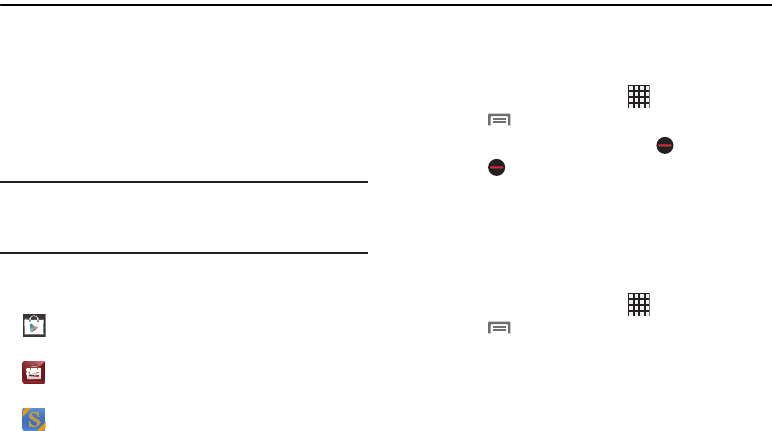
69
Section 6: Applications
Managing Applications
Apps displays all applications installed on your phone,
including apps you download and install.
From Apps, you can change the way apps appear on the
screen, uninstall apps you’ve downloaded, and share apps
with friends. When you install new apps, new screens are
added to hold them.
Tip:
You can place shortcuts to apps on the Home screen, for
quick access to the application. For more information, see
“Shortcuts” on page 31.
Downloading and Installing Apps
Find new apps to download and install on your device:
•
Play Store
: For more information, see
“Play Store”
on
page 93.
•
Verizon Apps
: For more information, see
“Apps”
on
page 73.
•
S Suggest
: For more information, see
“S Suggest”
on
page 93.
Uninstalling Apps
You can uninstall apps you download and install. Pre-loaded
apps cannot be uninstalled.
1. From the Home screen, touch
Apps
.
2. Touch
Menu
➔
Uninstall
.
3. Apps that can be uninstalled show on their icon.
Touch , then follow the prompts to uninstall the
app. Pre-loaded apps cannot be uninstalled.
Customizing the Apps Screens
Choosing a view
By default, app icons appear in Grid view. You can change
the view to list view.
1. From the Home screen, touch
Apps.
2. Touch
Menu
, then touch
View type
.
3. Choose an option:
• Customizable Grid
: The default view, which allows you to
touch and hold on apps to move them from screen to screen.
• Alphabetical grid
: Icons are arranged in a grid, in A-Z order.
• Alphabetical list
: Icons display in a list, sorted from A-Z.
DRAFT For Internal Use Only

Applications 70
Apps screen options
1. From the Home screen, touch
Apps.
2. Touch
Menu
for options:
•Play Store
: Launch Google
™
Play Store, to browse for new
apps to download.
•Edit
: Touch and hold an app icon for these options:
–
Drag it to a new location.
–
Drag it to to create a new folder to contain the icon.
–
Drag it to to create a new apps screen and place the icon
on it.
–
Drag it to to launch Application manager to view information
about the app. For more information, see
“Application
manager”
on page 134.
–
Drag to (if available) to remove the icon. The trashcan is
only available for apps you’ve installed. Pre-loaded apps cannot
be removed.
• Uninstall
: Remove an app that you downloaded from your
phone. Preloaded apps cannot be uninstalled.
• Downloaded applications
: Display all apps you’ve
downloaded.
•View type
: Configure the apps screen.
• Share apps
: Select apps you’ve downloaded (not available for
pre-loaded apps) to share via Backup Assistant Plus, Bluetooth,
Email, Gmail, Google+, Messaging, S Memo, or Wi-Fi Direct.
• Hide applications/Show hidden applications
: Control
whether app icons are visible in Apps. Hiding an icon does not
remove the app from your phone.
DRAFT For Internal Use Only

71
AllShare Play
Use AllShare Play to stream photos, music, and videos from
web storage, or between your phone and other DLNA (Digital
Living Network Alliance) certified devices.
For more information about AllShare Play, visit:
www.allshareplay.com
For more information about DLNA certified products, visit:
www.dlna.org/home
Your Samsung account manages the username and
password for several applications, including AllShare Play. To
use AllShare Play, you must be signed in to your Samsung
Account. For more information, see “Your Samsung Account”
on page 12.
Note:
AllShare Play uses Wi-Fi to communicate with other
devices. Before launching AllShare Play, connect to the
same Wi-Fi network as the device you want to stream
with. For more information, see “Wi-Fi” on page 98.
1. From the Home screen, touch
Apps
➔
AllShare Play
.
2. The first time you launch AllShare Play, read the user
agreement and follow the prompts to continue.
3. If you are not already signed in to your Samsung
account, touch
Sign in
and follow the prompts.
4. Choose a streaming option:
• Web storages
: Choose a web storage service, to stream
content from storage to your phone. To set up web storage
services, touch
Menu
➔
Web storages
.
• Devices
: Select content to share with other DLNA certified
devices on the same Wi-Fi network. To set up connections to
other devices, touch
Menu
➔
Devices
.
DRAFT For Internal Use Only

Applications 72
AllShare Play Options
1. From the Home screen, touch
Apps
➔
AllShare Play
.
2. Touch
Menu
for options:
•Refresh
: Update the AllShare Play screen to show content
available from other devices.
• Join Group Cast
: Interact and share on-screen images with
other devices on the same Wi-Fi network.
•Settings
: Configure AllShare Play.
–
Registered storage
: Configure access to a web storage
service, such as SugarSync. SugarSync is a web storage service
where you store up to 5 GB of files.
–
Registered Devices
: Configure devices to share content via
AllShare Play.
–
Setting up web services
: Sign in to web services, such as
Facebook, Twitter, YouTube, Picasa, or flickr, where you have
content stored.
–
Auto Upload photos from mobile
: Set up a connection
between your phone and a web storage service, to automatically
upload photos you take with your phone’s Camera to the
service.
–
Video quality settings
: Configure your phone’s playback of
videos.
–
Lock AllShare Play
: When locked, you must enter your
Samsung account credentials each time you launch AllShare
Play.
–
Language
: Choose a language for AllShare Play.
–
About
: View information about AllShare Play.
–
Contact Us
: Send a message to the AllShare Play team.
•My account
: Configure your Samsung account, used with
AllShare Play.
–
Account settings
: Access Account information, Change
password, and view Terms and conditions.
–
Sync Calendar
: Synchronize calendar information from your
device with your Samsung account.
–
Sync Contacts
: Synchronize contacts information from your
device with your Samsung account.
–
Sync Internet
: Synchronize internet details from your device
with your Samsung account.
–
Sync S Memo
: Synchronize memos created on your device in
the S Memo app with your Samsung account.
•FAQ
: Display frequently-asked questions about AllShare Play.
DRAFT For Internal Use Only

73
Amazon Kindle
Use the Amazon KindleTM application to download books for
reading, right on your phone.
Note:
You must be registered with Amazon to use the Kindle
application. At the prompt, enter your Amazon account
credentials.
From the Home screen, touch
Apps
➔
Amazon Kindle
.
Apps
Browse and download applications, games and more from
the Verizon Apps store.
From the Home screen, touch
Apps
.
– or –
From the Home screen, touch
Apps
➔
Apps
.
Note:
Airtime or download charges may apply when using
Apps.
Backup Assistant+
Backup Assistant Plus is a new service that integrates the
features and capabilities of Backup Assistant, V CAST Media
Manager, and Sync & Connect. Back up contacts, photos,
music, documents and videos to a secure, online storage
cloud. Access Backup Assistant Plus from a computer,
mobile phone, tablet, netbook or Web browser. All you need
is an active internet connection.
For more information, visit
www.verizonwireless.com/baplus
.
Note:
Subject to specific terms of use. Results may vary based
on backup schedule and other factors. Contact Verizon
Wireless for more information.
From the Home screen, touch
Contacts
, then
touch
Menu
➔
Backup
.
– or –
From the Home screen, touch
Menu
, then touch
Settings
➔
Backup Assistant Plus
.
DRAFT For Internal Use Only

Applications 74
Calculator
Use your phone’s Calculator to perform mathematical
calculations.
From the Home screen, touch
Apps
➔
Calculator
.
Calendar
Record events and appointments to manage your schedule.
Tip:
A Calendar widget is available in Widgets. For more
information about placing widgets on the Home screen,
see “Widgets” on page 30.
1. From the Home screen, touch
Apps
➔
Calendar
.
2. Touch , then select a view, from
Year
,
Month
,
Week
,
Day
,
Agenda
, or
Task
.
3. Touch
Menu
for options:
•Go to
: Display a specific date.
•Delete
: Delete an event.
•Search
: Search for calendar events.
•Sync
: Refresh Calendar with events from your accounts.
•Settings
: Customize the calendar.
Sending Events
Send events as vCalendar files to other Bluetooth devices, as
message attachments, or via Wi-Fi Direct.
1. From the Home screen, touch
Apps
➔
Calendar
.
2. Touch an event to display its details.
3. Touch
Menu
, then touch
Share via
, then follow the
prompts to select a sharing method and share the
event.
DRAFT For Internal Use Only
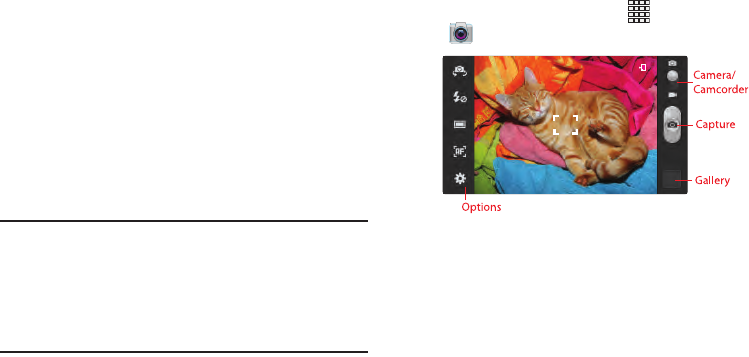
75
Camera
Use the Camera to take pictures and record video.
Sharing your photos and videos
Your device has exciting new features for sharing your
photos with your friends and family:
•
Use
Share Shot
to automatically share your photos and videos
with your friends and family via Wi-Fi Direct.
•
Use
S Beam
to transfer photos and videos (and other files) via
NFC to other NFC-capable devices, by simply touching the
devices together (typically back-to-back).
Important!
Do not take photos of people without their
permission.
Do not take photos in places where cameras are
not allowed.
Do not take photos in places where you may
interfere with another person’s privacy.
Taking Pictures
1. From the Home screen, touch
Apps
➔
Camera
.
2. Using the display as a viewfinder, compose your
picture by aiming the lens at the subject. You can
rotate the phone to any position, and the screen
controls rotate to make taking pictures easy.
3. As you compose a picture, the Camera automatically
focuses the shot (the focus bracket turns green), or:
•
Touch the screen to focus on the area you touched.
•
“Pinch” the screen, or press the Volume Key, to zoom in or out.
•
Configure other options. For more information, see
“Picture
Options”
on page 77.
4. To take the picture, touch
Capture
.
DRAFT For Internal Use Only

Applications 76
Gallery
After taking a picture, review the picture in Gallery, and use
options to modify or share the picture.
1. From the Home screen, touch
Apps
➔
Camera
.
2. Touch Gallery, then use these options:
•
“Pinch” the screen to zoom in or out, or double-tap to zoom all
the way in or out. When zoomed in, touch and drag your finger
on the screen to move the picture around on the screen.
•
Touch
Share
to send the picture.
•
Touch
Slideshow
to create a slideshow to view pictures.
•
Touch
Upload
to store your pictures with Backup Assistant
Plus.
•
Touch
Back
to return to the Camera to take more
pictures.
•
Touch
Menu
for options:
–
Delete
: Erase the picture.
–
Face tag
: When enabled, identifies faces with a yellow box, so
you can touch to add tag information.
–
Copy to clipboard
: Create a copy, to paste into other apps.
–
Rotate left/Rotate right
: Change the picture’s orientation.
–
Crop
: Change the picture’s size.
–
Set picture as
: Assign the picture as a Contact photo, or as
wallpaper.
–
Buddy photo share
: Send the picture to the people tagged in
the picture.
–
Print
: Print the picture via Wi-Fi to a compatible Samsung
printer.
–
Rename
: Change the picture’s filename.
–
Scan for nearby devices
: Search for nearby Wi-Fi devices for
sharing (available when Wi-Fi is turned On).
–
Details
: View information about the picture.
DRAFT For Internal Use Only

77
Picture Options
1. From the Home screen, touch
Apps
➔
Camera
.
2. Use these options to configure the camera:
• Self portrait
: Switch between the back camera and the
front camera, for self-portraits.
• Flash
: Choose Off, On, or Auto flash.
•
Shooting mode
: Choose an automatic shooting mode.
Some modes are not available for Self-portraits.
–
Single shot
: Take a single photo.
–
Burst shot
: Hold down the Camera button to take multiple
shots, then choose the best shots to keep.
–
HDR
: Take photos in High Dynamic Range (HDR) mode to
increase detail.
–
Smile shot
: Touch the Camera button to focus on the subject’s
face. If a smile is detected, the picture is taken automatically.
–
Beauty
: Adjust the contrast to create a smooth facial feature
effect.
–
Panorama
: Touch the Camera button to take a picture, then
use the on-screen guideline to move the viewfinder and take the
next 7 shots automatically.
–
Cartoon
: Apply a cartoon effect to pictures.
–
Share shot
: Share the pictures you take, with other devices via
Wi-Fi Direct. For more information, see
“Using Share Shot”
on page 80.
–
Buddy photo share
: When you take a picture, the Camera
recognizes faces from Contacts, so you can easily share the
picture with your friends.
• Focus mode
: Choose a method of focusing pictures.
• Settings
–
Edit shortcuts
: Choose shortcuts to appear on the toolbar.
Touch and drag shortcuts between the toolbar and the list.
–
Self-portrait
: When On, the Camera takes pictures with the
front Camera.
–
Flash
: Choose the default flash mode.
–
Shooting mode
: Choose the default mode for taking pictures.
–
Scene mode
: Choose a mode to match the kind of pictures
you’re taking.
–
Exposure value
: Set the default brightness level.
–
Focus mode
: Set the default focus mode.
–
Timer
: Set a delay to wait between touching the Camera button
and taking a picture.
DRAFT For Internal Use Only
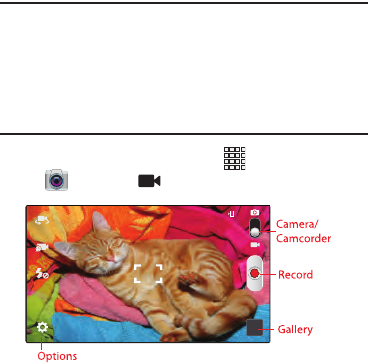
Applications 78
–
Effects
: Apply an effect to pictures.
–
Resolution
: Choose a size for the image.
–
White balance
: Choose a setting for the light source.
–
ISO
: Choose a setting for imaging sensitivity.
–
Metering
: Select a method for measuring light.
–
Anti-Shake
: When enabled, minimizes the effect of camera
movement.
–
Auto contrast
: Allow automatic light/dark adjustment.
–
Guidelines
: Enable or disable an on-screen grid to aid in photo
composition.
–
Image quality
: Choose a quality setting for photos.
–
GPS Tag
: Add GPS location information to photo details.
–
Reset
: Set all Camera settings to the defaults.
Recording Videos
Use the Camera to record video.
Important!
Do not take videos of people without their
permission.
Do not take videos in places where cameras are
not allowed.
Do not take videos in places where you may
interfere with another person’s privacy.
1. From the Home screen, touch
Apps
➔
Camera
➔
Camera/Camcorder
.
DRAFT For Internal Use Only

79
2. Using the display as a viewfinder, compose your shot
by aiming the lens at the subject. You can rotate the
phone to any position, and the screen controls rotate to
make recording easy.
3. As you compose a shot, the Camera automatically
focuses the shot (the focus bracket turns green), or you
can:
•
“Pinch” the screen
to zoom in or out.
•
Configure options. For more information, see
“Video
Options”
on page 79.
4. To start recording, touch
Record
. During recording:
•
Touch to capture a still shot. This feature is not available
when the Anti-shake option is enabled.
•
Touch the screen to focus on the area you touched.
•
Touch the
Stop
button.
5. After recording, touch
Gallery
to view the video. While
viewing the video, use these options:
•
Touch
Play
to review the video.
•
Touch
Share
to send the video.
•
Touch
Slideshow
to create a slideshow to view pictures
and videos.
•
Touch
Upload
to store your videos with Backup Assistant
Plus.
•
Touch
Menu
for options:
–
Delete
: Erase the picture.
–
Rename
: Change the picture’s filename.
–
Scan for nearby devices
: Search for nearby Wi-Fi devices for
sharing (available when Wi-Fi is turned On).
–
Details
: View information about the picture.
•
Touch
Back
to return to the Camcorder to record more
videos.
Video Options
Configure the camcorder.
1. From the Home screen, touch
Apps
➔
Camera
➔
Mode
.
2. Use these options to configure the camera:
• Self recording
: Record video with the front lens.
• Recording mode
: Choose a recording mode, from:
–
Normal
: Record a video of any length.
–
Limit for MMS
: Restrict the length of the video so it can be sent
as a message attachment.
• Flash
: Choose Off or On.
DRAFT For Internal Use Only

Applications 80
• Settings
:
–
Edit shortcuts
: Choose shortcuts to appear on the toolbar.
Touch and drag shortcuts between the toolbar and the list.
–
Self-recording
: When On, the Camera records with the front
Camera.
–
Flash
: Choose the default flash mode.
–
Recording mode
: Choose the default recording mode.
–
Exposure value
: Set the default brightness level.
–
Timer
: Set a delay to wait between touching the Camera button
and taking a picture.
–
Effects
: Apply an effect to pictures.
–
Resolution
: Choose a size for the image.
–
White balance
: Choose a setting for the light source.
–
Anti-Shake
: When enabled, minimizes the effect of camera
movement.
–
Guidelines
: Enable or disable an on-screen grid to aid in photo
composition.
–
Video quality
: Choose a quality setting for videos.
–
Storage
: Choose the default save location for videos, if an
optional memory card is installed.
–
Reset
: Set all settings to the defaults.
Sharing Pictures and Video
Using Share Shot
Set up a connection with other Wi-Fi Direct devices, then
take pictures to share them in real-time.
1. Turn on Wi-Fi Direct. For more information, see
“Turning Wi-Fi Direct On or Off” on page 100.
2. Enable Share Shot shooting mode in Camera:
•
From the Home screen, touch
Apps
➔
Camera
.
•
Touch
Settings
➔
Shooting mode
➔
Share shot
.
•
Touch , then select devices to share your pictures with.
3. Take photos. For more information, see “Taking
Pictures” on page 75. The photos you take while in
Share Shot mode are shared automatically with
connected devices, and your phone displays an alert in
the Status bar and Notifications.
DRAFT For Internal Use Only

81
Using S Beam
Enable NFC and S Beam, then share pictures, videos (and
other files) with other NFC-capable devices.
1. Activate NFC. For more information, see “NFC and
Beaming” on page 105.
2. Activate S Beam. For more information, see “S Beam”
on page 106.
3. Choose pictures, videos, or other files for sharing. This
can be in Gallery, from My files, or from another app
with file-sharing capability.
4. Select a file to display it, then touch the devices back-
to-back. At the prompt, touch the picture to beam it to
the other device.
Clock
The Clock application includes these features:
•
Alarm
: Create alarms to go off once, or to repeat.
•
World clock
: Display the time and date in any time zone.
•
Stopwatch
: Record lap times.
•
Timer
: Measure elapsed time.
•
Desk clock
: Display the date and time in large format, for easy
viewing.
From the Home screen, touch
Apps
➔
Clock
.
Color
Use Color for Facebook to instantly capture and share live
video broadcasts and photos with friends on Facebook. With
Color, you can share everyday moments LIVE, as they
happen.
For more information about Color, visit:
www.color.com
From the Home screen, touch
Apps
➔
Color
.
DRAFT For Internal Use Only

Applications 82
Contacts
Use Contacts to store information for your friends, family and
colleagues, to make contacting them easy.
For more information, see “Contacts” on page 38.
From the Home screen, touch
Apps
➔
Contacts
.
Downloads
View and manage files and other items you download to your
phone.
1. From the Home screen, touch
Apps
➔
Downloads
.
2. Touch an item to open it (if an appropriate application
is installed.)
Note:
Applications you download in Google Play™ Store are
managed in Play Store, and will not appear in
Downloads.
Email
Send and receive email using popular email services.
For more information, see “Email” on page 64.
From the Home screen, select
Apps
➔
Email
.
Gallery
Use Gallery to view, capture, and manage pictures and
videos.
Viewing Videos
1. From the Home screen, touch
Apps
➔
Gallery
.
2. Touch an album, then touch a video to play it.
3. While viewing videos, touch
Menu
for options.
Viewing Pictures
1. From the Home screen, touch
Apps
➔
Gallery
.
2. Touch an album, then touch a picture to view it.
3. While viewing a picture, touch the screen, or touch
Menu
for options.
DRAFT For Internal Use Only

83
Sharing pictures and video
You can share pictures and videos via Email, Messaging,
Bluetooth or popular sharing services.
1. From the Home screen, touch
Apps
➔
Gallery
.
2. Touch an album to display thumbnails, then select
items for sharing:
•
To select an entire category, touch
Menu
while viewing
categories, then touch the category to select all pictures in the
category.
•
To select multiple pictures or videos from a category, touch
Menu
while viewing the thumbnails. Touch thumbnails to
mark them for sharing, then touch
Share
.
3. Touch an option, then follow the prompts.
Setting a Picture as a Contact Photo
Set a picture as a contact’s photo. The contact’s photo will
appear with notifications to calls or messages from the
contact.
1. From the Home screen, touch
Apps
➔
Gallery
.
2. Touch a category, then touch a picture to select it.
3. Touch
Menu
➔
Set picture as
➔
Contact photo
.
4. Select a contact, or create a new contact, with the
selected picture as the contact’s photo.
Setting a Picture as Wallpaper
Set a picture as the wallpaper for the Home and Lock
screens.
1. From the Home screen, touch
Apps
➔
Gallery
.
2. Touch a category, then touch a picture to select it.
3. Touch
Menu
➔
Set picture as
.
4. Select an option, from Home and lock screens, Home
screen wallpaper, or Lock screen wallpaper. Use the
crop tool to edit the picture, then touch
Done
.
DRAFT For Internal Use Only

Applications 84
Gmail
Send and receive emails via Gmail, Google’s web-based
email.
For more information, see “Gmail” on page 66.
From the Home screen, touch
Apps
➔
Gmail
.
Google+
Google+ makes messaging and sharing with your friends a
lot easier. Set up Circles of friends, visit the Stream for
updates from your Circles, use Messenger, or use Instant
Upload to automatically upload photos and videos from your
phone to your private album on Google+.
For more information, visit:
www.google.com/+
From the Home screen, touch
Apps
➔
Google+
.
Guided Tours
Get information about using your phone, including videos,
useful tips, and a user manual.
From the Home screen, touch
Guided Tours
.
– or –
From the Home screen, touch
Apps
➔
Guided Tours
.
DRAFT For Internal Use Only

85
Internet
Your phone is equipped with a full HTML Browser, which
allows you to access the internet.
From the Home screen, touch
Internet
.
– or –
From the Home screen, touch
Apps
➔
Internet
.
Navigating the Internet
Command Keys
•
Touch
Back
to return to the previous page.
•
To go forward,
touch
Menu
, then touch
Forward
.
Touching and dragging
•
Touch and drag your finger on the screen to navigate pages, and
to reposition pages within the screen.
Entering text in a field
•
While browsing, touch a text field to display the virtual QWERTY
keyboard to enter text.
Zoom
•
Tap the screen twice to zoom in or out.
Selecting items on a page
While browsing pages, use gestures and menus to navigate:
•
Touch an item to select it.
•
Touch a hyperlink to follow the link.
•
Touch and hold on a hyperlink for options.
Entering a URL
Access a website quickly by entering the URL.
1. From the Home screen, select
Internet
.
2. Touch the
URL
field at the top of the screen to enter the
URL using the virtual QWERTY keyboard, then touch
Go
.
Using Windows
You can have multiple windows open at one time, and you
can switch between windows.
•
To open a new window, touch
Windows
➔
Add
.
•
To switch to another open window, touch
Windows
, then
touch a window to display it.
•
To close a window, touch
Windows
, then touch beside
a window to close it.
1
1
1
DRAFT For Internal Use Only

Applications 86
Using Bookmarks
While browsing, bookmark a site to quickly access it later.
Creating a bookmark
1. From the Home screen, touch
Internet.
2. Browse to the desired website, then touch
Bookmarks
➔
Add bookmark
.
3. Confirm the Name and Folder for the bookmark, then
touch
Save
.
Accessing bookmarks and history
Launch a bookmarked page, or reload recent pages.
1. From the Home screen, touch
Internet
.
2. Touch
Bookmarks
to display bookmarks, then use
these options:
•
Touch an item to load the page.
•
Touch and hold on an item for options.
•
Touch
Menu
for more options.
Kies Air
It’s time to share wirelessly. Kies Air makes it easy to
manage content saved on your device via your desktop or
mobile browser using Wi-Fi technology. Without any need for
cables, you can easily play and transfer media files, manage
data, and more.
For more information, visit:
www. samsung.com/us/kies
From the Home screen, touch
Apps
➔
Kies Air
.
Latitude
Use Google Latitude to locate your friends on a map, and
share or hide your location.
From the Home screen, touch
Apps
➔
Latitude
.
DRAFT For Internal Use Only

87
Maps
Use Google Maps to find your current location, plus get
directions and other location-based information.
Note:
You must enable location services to use Maps, and
some features require Standalone or Google location
services. For more information, see “Location services”
on page 137.
From the Home screen, touch
Apps
➔
Maps
.
Navigating the Map
Zooming
•
Double-tap on the screen to zoom in.
•
Touch Zoom in or Zoom out.
Scrolling
•
Touch and drag on the screen to reposition the map in the display.
Touch
•
Touch an icon on the map to display information about the
location.
Media Hub
Samsung Media Hub is your one stop for the hottest movie
and TV content. Preview, rent, or buy blockbuster hits as well
as classic movies and TV shows.
For more information, visit:
http://www.samsung.com/us/mediahub/
Note:
Renting or purchasing content in Media Hub requires a
Samsung account.
1. From the Home screen, select
Apps
➔
Media Hub
.
2. Browse content, then follow the prompts to buy or rent.
You must have a Samsung account to rent or buy
media.
DRAFT For Internal Use Only

Applications 88
Messaging
Send and receive text and multimedia messages.
For more information, see “Text and Multimedia Messaging”
on page 61.
From the Home screen, touch
Messaging
.
– or –
From the Home screen, touch
Apps
➔
Messaging
.
Messenger
Google+ Messenger lets you chat and coordinate with any of
your friends, all at the same time.
For more information, visit:
www.google.com/+
From the Home screen, touch
Apps
➔
Messenger
.
Mobile Hotspot
Use Mobile Hotspot to share your phone’s mobile internet
connection with up to 10 devices, using your phone as the
mobile hotspot.
For more information, see “Mobile Hotspot” on page 101.
From the Home screen, touch
Apps
➔
Mobile Hotspot
.
Music Hub
Music Hub is all the music you want in one integrated mobile
and web service. Upload your music collection to the cloud,
and access our entire catalog of millions of songs. Enjoy
personal and genre radio and discover new music every day
with customized recommendations.
For more information, visit:
www.musichub.com
From the Home screen, touch
Apps
➔
Music Hub
.
DRAFT For Internal Use Only

89
Music Player
Music Player plays songs stored on your phone or an
installed memory card.
1. From the Home screen, select
Apps
➔
Music
Player
.
2. Music Player scans for songs stored in phone memory,
or on an installed memory card and displays your
songs on the
All
,
Playlists
,
Albums
,
Artists
,
Music
Square
, and
Folders
tabs.
3. Touch a video to begin playback. During playback, use
the sound and playlist controls:
•
Volume
: Touch to activate on-screen volume control,
then touch and drag on the scale to set volume, or press the
Volume Key on the side of the phone to adjust playback
volume. If you have motion settings turned on, place the phone
screen-down to mute playback.
•
Shuffle
: When enabled, songs play in random order.
When disabled, songs play in the order they appear in List view.
•
Repeat
: Touch to repeat the current song, repeat all
songs, or disable repeat mode.
•
List /
Now Playing
: Touch
List
to switch to a list
view of songs. Touch
Now Playing
to display the current song
title and details.
•
Touch
to choose an effect for music playback.
•
Touch to advance to the next song. Touch and hold
to scan forward through the current song.
•
Touch to go back to the previous song. Touch and hold
to scan backward through the current song.
•
Touch to pause playback. Touch to resume playback.
Creating a Playlist
1. From the Home screen, select
Apps
➔
Music
Player
➔
Playlists
.
2. Touch
Menu
➔
Create Playlist
, then enter a name
for the playlist.
3. Touch
OK
, then touch Add music to choose music for
the playlist.
DRAFT For Internal Use Only

Applications 90
Adding a song to a playlist
1. From the Home screen, select
Apps
➔
Music
Player
.
2. Touch and hold on a song, then choose
Add to playlist
from the pop-up menu.
3. Touch a playlist to add the selected song to it, or touch
Create new playlist
to create a new playlist and add the
selected song to it.
Adding multiple songs to a playlist
1. From the Home screen, select
Apps
➔
Music
Player
.
2. Touch
Menu
➔
Add to playlist
.
3. Touch songs to select them, or touch
Select all
, then
touch
Done
.
4. Select a playlist, or touch
Create new playlist
to create
a new playlist.
Setting a Song as a Ringtone
You can set a song as a ringtone for all voice calls, for calls
from an individual contact, or as an alarm tone.
1. From the Home screen, select
Apps
➔
Music
Player
.
2. Touch and hold on a song, then touch
Set as
and
choose from these options:
• Phone ringtone
: Set the song as the default ringtone for all
incoming voice calls.
• Caller ringtone
: Choose a contact to set the song as the
ringtone for calls from the contact.
• Alarm tone
: Set the song as the alarm ringtone for a new
alarm, or for an existing alarm.
DRAFT For Internal Use Only

91
My Files
Find, view and manage files stored on an installed memory
card. If the file is associated with an application on your
phone, you can launch the file in the application.
1. From the Home screen, touch
Apps
➔
My Files
.
2. Tap a folder and swipe your finger on the screen to
browse files.
3. Touch a file to open it (if the file is associated with an
application).
4. While browsing files, use these controls:
•
Touch
Up
to go back up to a higher directory.
•
Touch
Home
to go back to the root directory.
•
Touch
Menu
for options.
My Verizon Mobile
View details and manage your Verizon Wireless account.
Note:
No airtime or minute charges apply when accessing My
Verizon Mobile.
From the Home screen, touch
Apps
➔
My Verizon Mobile
.
Navigation
Use Google Navigation to search for locations, and get turn-
by-turn directions.
Note:
You must enable location services to use Navigation,
and some features require Standalone or Google
location services. For more information, see “Location
services” on page 137.
From the Home screen, touch
Apps
➔
Navigation
.
DRAFT For Internal Use Only

Applications 92
Phone
Place calls, review recent calls, or dial a number to send a
message.
For more information, see “Calling” on page 49.
From the Home screen, touch
Phone
.
Local
Google Places is now Google Local, to use your location to
help you find destinations, such as restaurants, bars, hotels,
attractions, ATMs and gas stations, or you can enter a
location.
Note:
You must enable location services to use Local, and
some features require Standalone or Google location
services. For more information, see “Location services”
on page 137.
From the Home screen, touch
Apps
➔
Local
.
Play Books
Google Books is now Google Play™ Books. Discovering your
favorite books and authors has never been easier. With
Google Play Books, you can shop the world's largest
selection of ebooks and read them anywhere you like - on a
tablet, phone, ereader, or the Web.
From the Home screen, touch
Apps
➔
Play Books
.
Play Movies
With Google Play™ Movies, you can rent thousands of
different movies, to watch instantly, or download for offline
viewing later. You’ll need to have a Google account set up on
your phone to download a new application.
From the Home screen, touch
Apps
➔
Play Movies
.
DRAFT For Internal Use Only

93
Play Music
With Google Play™ Music, you can play music you’ve
downloaded, and music you copied from your computer.
You’ll need to have a Google account set up on your phone to
download a new application.
From the Home screen, touch
Apps
➔
Play Music
.
Play Store
Android Market is now Google Play™ Store, where all your
favorite books, movies, apps, and games are all in one place
that’s accessible from the Web and your Android device.
You’ll need to have a Google account set up on your phone to
download a new application.
1. From the Home screen, select
Apps
➔
Play Store
.
2. The first time you open Play Store, read the Terms of
Service, then touch
Accept
to continue.
3. Browse for applications to download, then follow the
prompts.
S Memo
Record ideas instantly and freely with memos containing
text, pictures, handwritten notes or drawings, and voice
recordings.
1. From the Home screen, select
Apps
➔
S Memo
.
2. To create a new memo, touch an option:
•
Touch a template thumbnail.
•
Text mode
: Open a memo to enter text with the
keyboard.
•
Drawing mode
: Open a memo to draw or write text.
Tip:
To view a tutorial for S Memo, touch
Menu
➔
Tutorial
.
S Suggest
S Suggest presents recommendations for popular
applications you can install on your phone.
From the Home screen, select
Apps
➔
S Suggest
.
DRAFT For Internal Use Only
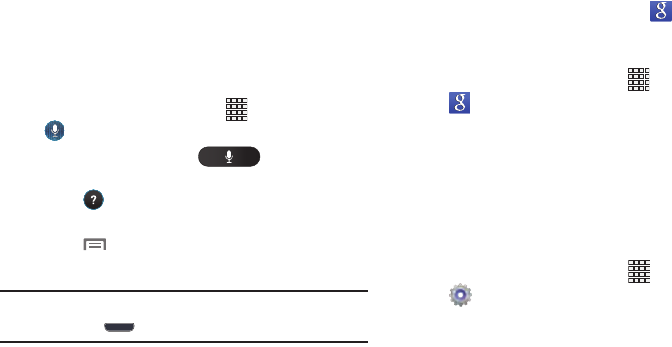
Applications 94
S Voice
Use S Voice to speak commands to perform operations on
your phone, and to speak criteria for searches and other
operations. Just speak naturally, and S Voice understands
what you’re looking for. use the power of S Voice to find
everything from directions to trivia answers to the current
weather forecast.
1. From the Home screen, select
Apps
➔
S Voice
.
2. Say “Hi Galaxy”, or touch to wake up
S Voice, then speak a command or question.
Touch for a list of commands, then touch a
command to see examples.
3. Touch
Menu
➔
Settings
to configure settings to
your preferences.
Tip:
You can launch S Voice from most unlocked screens by
pressing the
Home Key
twice.
Search
Use Google Search to search the Web.
1. From the Home screen, touch the
Google Search
Widget.
– or –
From the Home screen, touch
Apps
➔
Google Search
.
2. Enter search criteria. Search results display
automatically. Touch a search result to display it in a
browser window.
Settings
Configure your phone to your preferences. For more
information, see “Settings” on page 111.
From the Home screen, touch
Apps
➔
Settings
.
DRAFT For Internal Use Only

95
Setup Wizard
Use the Setup wizard to quickly configure your phone.
From the Home screen, touch
Apps
➔
Setup wizard
.
Talk
Chat with other Google Talk users.
Note:
Talk requires a Google account. For more information,
see “Setting Up Your Accounts” on page 37. When you
set up your Google account on your device, you are
automatically logged in.
From the Home screen, select
Apps
➔
Talk
.
V CAST Tones
Preview, purchase, and download ringtones and ringback
tones.
Note:
Airtime or download charges may apply.
1. From the Home screen, select
Apps
➔
V CAST Tones
.
2. The first time you launch the app, you’ll be prompted to
create a profile. Follow the prompts to install and use
the app.
DRAFT For Internal Use Only

Applications 96
Video Player
Use Video Player to view and manage videos stored on an
installed memory card, or shop for new videos.
1. From the Home screen, touch
Apps
➔
Video player
.
2. Video Player scans for videos stored in phone memory,
or on an installed memory card, and displays your
videos on the
Thumbnails
,
List
, and
Folders
tabs.
3. Touch a video to play it. While playing a video, touch
the screen to display or hide on-screen Forward,
Pause, and Back playback controls.
4. During playback, use the sound and playlist controls:
•
Volume
: Touch to activate on-screen volume control, then
touch and drag on the scale to set volume, or press the Volume
Key on the side of the phone to adjust playback volume. If you
have motion settings turned, turn the phone screen-down to
mute playback.
•
Full screen
: Switch to viewing the video in full screen
mode, to use the entire display.
•
Pop Up Play
: Touch to display the video in a small
window at the top right corner of the screen, so you can watch
the video while using other phone features. Touch the small
window to return to Video Player. Only available for non-DRM
protected videos.
•
Touch to advance to the next song. Touch and hold
to scan forward through the current song.
•
Touch to go back to the previous song. Touch and hold
to scan backward through the current song.
•
Touch to pause playback. Touch to resume playback.
5. While playing a video, touch
Menu
for options.
Voice Recorder
Record your voice or other sounds, and share recordings via
Bluetooth, Messaging, or Gmail.
From the Home screen, touch
Apps
➔
Voice Recorder
.
DRAFT For Internal Use Only
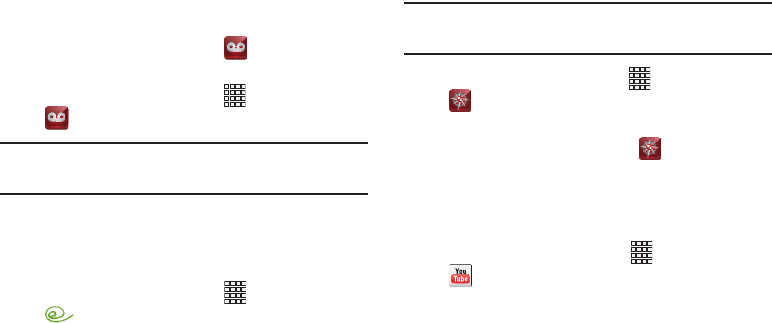
97
Voicemail
All unanswered calls to your phone are sent to voicemail,
even if your phone is turned off, so you’ll want to set up your
voicemail and personal greeting as soon as you activate your
phone.
From the Home screen, touch
Voicemail
.
– or –
From the Home screen, touch
Apps
➔
Voicemail
.
Note:
For more information about setting up and checking
voicemail, see “Voicemail” on page 67.
VPN Client
Easily configure connections to a VPN (Virtual Private
Network).
From the Home screen, touch
Apps
➔
VPN Client
.
VZ Navigator
Use VZ Navigator® to find, share and navigate to millions of
locations, avoid traffic and drive or walk with ease.
Note:
VZ Navigator requires service activation. Contact Verizon
Wireless for more information.
From the Home screen, touch
Apps
➔
VZ Navigator
.
– or –
From a Home screen, touch the
VZ Navigator
shortcut
.
YouTube
View and upload YouTube videos, right from your phone.
From the Home screen, select
Apps
➔
YouTube
.
DRAFT For Internal Use Only

Connections 98
Section 7: Connections
Wi-Fi
Wi-Fi is a wireless networking technology that provides
access to local area networks.
Wi-Fi communication requires access to an existing Wi-Fi
network. Wi-Fi networks can be Open (unsecured), or
Secured (requiring you to provide login credentials).
Your phone supports the 802.11 a/b/g/n Wi-Fi protocols.
Configuring Wi-Fi Settings
Configure your phone’s Wi-Fi settings. For more information,
see “Wi-Fi Settings” on page 112.
Turning Wi-Fi On or Off
Turn your phone’s Wi-Fi service on or off. When you turn Wi-
Fi service on, your phone automatically searches for nearby
available Wi-Fi networks.
Tip:
When you turn Wi-Fi service on, your phone automatically
searches for available networks and displays them.
You can also turn Wi-Fi On or Off from Settings.
1. From the Home screen, sweep your finger downward
to display Notifications.
2. If Wi-Fi is not already on, touch
Wi-Fi
Off
to turn on
Wi-Fi.
– or –
Touch
Wireless network available
to launch Wi-Fi
settings, then touch
Wi-Fi
.
DRAFT For Internal Use Only

99
Scanning and Connecting to a Wi-Fi Network
When you turn on Wi-Fi, your phone searches for available
Wi-Fi connections, then displays them.
1. From the Home screen, sweep your finger downward
to display Notifications.
2. If Wi-Fi is not already on, touch
Wi-Fi
Off
to turn on
Wi-Fi.
– or –
Touch
Wireless network available
to launch Wi-Fi
settings, then touch
Wi-Fi
.
3. When your phone completes a scan, touch a Wi-Fi
network to connect. If the Wi-Fi network is open, you
will be automatically connected. If the Wi-Fi network is
secured, enter the password at the prompt to connect.
Adding a Wi-Fi Network Manually
1. From the Home screen, sweep your finger downward
to display Notifications.
2. If Wi-Fi is not already on, touch
Wi-Fi
Off
to turn on
Wi-Fi.
– or –
Touch
Wireless network available
to launch Wi-Fi
settings, then touch
Wi-Fi
.
3. On the pop-up Wi-Fi settings screen, touch
Add
Network
(below the scanned networks), then enter
these fields:
• Network Name (SSID)
: Enter the name of the Wi-Fi network.
• Security
: Select the type of security used by the Wi-Fi network.
• Password
: If the network is secured, enter the password.
4. Touch
Connect
to save the settings and connect to the
network now, or
Save
to save the network settings for
future use.
DRAFT For Internal Use Only

Connections 100
Wi-Fi Direct
Wi-Fi Direct is a standard that allows devices to connect to
each other directly via Wi-Fi, without a Wi-Fi network or
hotspot, and without having to set up the connection. This
type of connection is commonly called peer-to-peer.
For example, your device can use Wi-Fi Direct to share
photos, contacts and other content with other Wi-Fi Direct
devices. Many of the apps on your device provide options for
sharing via Wi-Fi Direct under
Menu
.
Turning Wi-Fi Direct On or Off
1. From the Home screen, touch
Menu
, then select
Settings
➔
More settings
.
2. Touch
Wi-Fi Direct
to turn Wi-Fi Direct On or
Off.
Connecting to Wi-Fi Direct Devices
1. First, enable Wi-Fi Direct on your device. From the
Home screen, touch
Menu
, then select
Settings
➔
More settings
, then touch
Wi-Fi Direct
.
2. Enable Wi-Fi Direct on the other device(s). Consult the
other device’s documentation for more information.
3. On your device, touch
Wi-Fi Direct
to scan for the other
device(s).
4. In the scanned list, touch a device to connect with it, or
touch
Multi-connect
to connect to multiple devices (not
all devices support multi-connect).
5. Follow the prompts on both devices to complete the
connection.
DRAFT For Internal Use Only

101
Mobile Hotspot
Use Mobile Hotspot to share your phone’s internet connection
with a PC or other device through Wi-Fi, using your phone as
the mobile hotspot.
Note:
Mobile Hotspot requires a subscription to Mobile
Hotspot/Mobile Broadband Connect service. Contact
Verizon Wireless for more information.
Mobile Hotspot consumes battery power and uses data
service. While the Mobile Hotspot is active, your phone’s
applications will use the Mobile Hotspot data allowance.
Configuring Mobile Hotspot Settings
Configure your phone’s Mobile Hotspot settings, including
your phone’s name and password, and set the visibility of
your phone’s Wi-Fi hotspot.
For more information, see “Configuring Mobile Hotspot” on
page 114.
Turning Mobile Hotspot On or Off
Activate your phone’s Mobile Hotspot application to allow
other devices to use your phone’s internet connection.
1. From the Home screen, select
Apps
➔
Mobile Hotspot
.
2. Touch
Mobile Hotspot
to turn the hotspot On or
Off.
Tip:
By default, your device’s mobile hotspot has no security
applied, and any device can connect. For more
information about configuring your mobile hotspot, see
“Configuring Mobile Hotspot” on page 114.
DRAFT For Internal Use Only

Connections 102
Connecting a Device via Mobile Hotspot
Use the other device’s Wi-Fi control to connect to your
device’s Mobile Hotspot.
1. Turn on Mobile Hotspot on your phone. For more
information, see “Turning Mobile Hotspot On or Off” on
page 101.
2. Activate Wi-Fi on the device, using the device’s Wi-Fi
control.
3. Scan for Wi-Fi hotspots, and select your device from
the list. To find your device’s name, see “Configuring
Mobile Hotspot” on page 114.
4. At the prompt, enter your phone’s Mobile Hotspot
password. By default, the password is your phone’s
telephone number. For more information, see
“Configuring Mobile Hotspot” on page 114.
Bluetooth
Note:
For Hearing Aid Compatibility Information, see page 178.
Bluetooth is a short-range wireless communications
technology for exchanging information over a distance of
about 30 feet. You don’t need to line up the devices to send
information with Bluetooth. If the devices are in range, you
can exchange information between them, even if they are in
different rooms.
Your device can use Bluetooth to share photos, contacts and
other content with other Bluetooth devices. Many of the apps
on your device provide options for sharing via Bluetooth
under
Menu
.
Configuring Bluetooth Settings
Configure your phone’s Bluetooth settings. For more
information, see “Bluetooth settings” on page 116.
Note:
Bluetooth profiles are specifications for services
supported by individual devices. For a list of profiles your
phone supports, see “Bluetooth profiles” on page 115.
DRAFT For Internal Use Only

103
Turning Bluetooth On or Off
1. From the Home screen, touch
Menu
, then select
Settings
.
2. Touch
Bluetooth
to turn Bluetooth On or Off.
Tip:
You can also turn Bluetooth On or Off on Notifications.
From almost any unlocked screen, sweep your finger
down from the Status bar to display Notifications.
Pairing with a Bluetooth Device
Search for a Bluetooth device and pair with it, to exchange
information between your phone and the device.
After pairing, your phone and the target device will recognize
each other and exchange information without a passcode or
PIN.
Note:
When paired, the
Bluetooth paired
icon displays in
the Status Bar. If you receive a new request for pairing
while paired with a Bluetooth headset, a new Bluetooth
icon displays at the left of the Status bar and
Notifications displays the pairing request.
1. From the Home screen, touch
Menu
, then select
Settings
➔
Bluetooth
.
2. Touch
Bluetooth
to turn Bluetooth On.
3. Activate the target device’s discoverable mode.
4. Touch
Scan
.
5. From the list of scanned devices, touch the target
device, then follow the prompts to complete the
pairing:
•
If the target device requires a PIN, enter a PIN for the target
device and touch
OK
. When prompted, enter the PIN on the
target device.
•
If the device allows automatic or smart pairing, your phone will
attempt to pair with the phone automatically. Follow the
prompts on your phone and the target device to complete the
pairing.
DRAFT For Internal Use Only

Connections 104
VPN
You can use your phone’s VPN (Virtual Private Network)
feature to connect to VPNs.
Configuring VPN Settings
Configure your phone’s VPN settings. For more information,
see “VPN” on page 119.
Note:
You must enable at least Pattern security before setting
up a VPN. If you have not yet enabled security, you’ll be
prompted to do so the first time you launch VPN
settings.
Adding a VPN
1. From the Home screen, touch
Menu
, then select
Settings
➔
More settings
➔
VPN
.
2. Touch
Add VPN network
to set up a connection to a
VPN. Available settings depend on the type of VPN.
Tethering
Use Tethering to share your phone’s internet connection with
a computer that connects to your device via USB cable, or by
Bluetooth.
Note:
Touch
Help
under Tethering settings to view information
about tethering, and for links to more information.
USB tethering
Use USB tethering to share your device’s network connection
with a computer that connects to your device via USB cable.
1. From the Home screen, touch
Menu
, then select
Settings
➔
More settings
➔
Tethering
.
2. Connect the other device to your device via USB cable.
3. Touch
USB tethering
to turn tethering On or Off.
DRAFT For Internal Use Only

105
Bluetooth tethering
Before starting, pair your computer with your phone, then
configure your computer to obtain its network connection via
Bluetooth.
1. From the Home screen, touch
Menu
, then select
Settings
➔
More settings
➔
Tethering
.
2. Connect the other device to your device via USB cable.
3. Touch
Bluetooth tethering
to turn tethering On or Off.
Important!
Tethering consumes battery power and increases
your data usage. Roaming while using tethering
will incur extra data charges.
NFC and Beaming
Use NFC (Near Field Communication) to share information
between your device and another NFC device by beaming,
typically by touching the devices together back-to-back.
Your device uses NFC for the Android Beam and S Beam
features. NFC must be turned on to use Android Beam or S
Beam.
1. From the Home screen, touch
Menu
, then select
Settings
➔
More settings
.
2. Touch
NFC
to turn NFC On or Off.
Note:
NFC must be turned on to use Android Beam or S Beam.
DRAFT For Internal Use Only

Connections 106
Android Beam
Android Beam uses your phone’s NFC (Near Field
Communication) feature to send, or “beam”, content to
another NFC-capable device, by holding the devices close
together, typically back-to-back.
Use the sharing options from your favorite apps to select
content to share via Android Beam. You can beam browser
pages, YouTube videos, contacts, and more.
1. From the Home screen, touch
Menu
, then select
Settings
➔
More settings
.
2. Touch
NFC
to turn NFC On. NFC must be turned On to
use Android Beam.
3. Touch
Android Beam
, then touch to turn
Android Beam On or Off.
S Beam
Share more and share it faster with S Beam. From photos to
documents, large video files to maps, you can share almost
anything instantly with one touch, simply by placing your
phones back-to-back.
S Beam uses your phone’s NFC (Near Field Communication)
feature to send, or “beam”, content to other NFC and Wi-Fi
Direct devices, by holding the devices close together.
S Beam works in the background. Use the sharing options
from your favorite apps to select content to share via
S Beam. For example, you can beam pictures or videos from
Gallery, or songs from Music player. Just bring the devices
together (typically back-to-back), then tap the screen.
1. From the Home screen, touch
Menu
, then select
Settings
➔
More settings
.
2. Touch
NFC
to turn NFC On. NFC must be turned On to
use S Beam.
3. Touch
S Beam
, then touch to turn S Beam On
or Off.
Note:
If you turn on S Beam, NFC is automatically turned On.
DRAFT For Internal Use Only

107
Nearby devices
Share files with nearby devices using DLNA (Digital Living
Network Alliance) standards, over Wi-Fi.
To share with nearby devices, you must connect to a Wi-Fi
network. The devices you wish to share files with must also
be connected to the same Wi-Fi network and must support
DLNA.
Important!
Use care when enabling file sharing for nearby
devices. When enabled, other devices can access
data on your device.
Turning File sharing On or Off
1. From the Home screen, touch
Menu
, then select
Settings
➔
More settings
➔
Nearby Devices
.
2. Touch
File sharing
to turn sharing On or Off.
Configuring File Sharing
1. From the Home screen, touch
Menu
, then select
Settings
➔
More settings
➔
Nearby Devices
.
2. Under
Advanced
, touch options to control how content
is shared from your device:
• Shared contents
: Choose the type of content to share, from
Videos
,
Photos
, or
Music
.
• Device name
: View or modify your device’s name.
• Access control
: Choose whether other devices access your
content, from
Allow all
or
Only allowed devices
.
• Allowed devices list
: View and manage devices allowed to
connect to your device.
• Not-allowed devices list
: View and manage devices restricted
from connecting to your device.
•Download to
: Choose a location to save downloaded content,
from USB storage (phone memory) or SD card.
• Upload from other devices
: Choose how to handle incoming
files from other devices, from
Always accept
,
Always ask
, or
Always reject
.
DRAFT For Internal Use Only

Connections 108
Connecting to a Computer
Connect your device to a computer to transfer data between
your device and the computer. Use the USB cable that comes
with your device, or use one of the pre-loaded apps on your
device to connect wirelessly.
Transferring Data
Connect your device to a computer, via USB cable, to transfer
data as a Media device using MTP (Media Transfer Protocol),
or as a Camera using PTP (Photo Transfer Protocol).
1. Attach your phone to the computer with a USB data
cable. Your phone recognizes the connection as the
last connection method you used, and displays a
connection
alert in the Status bar and Notifications.
2. From the Home screen, sweep your finger downward
to display Notifications, then touch the alert.
3. Select a connection method:
• Media device (MTP)
: Transfer media files with Windows, or
using Android file transfer on a Mac (see
www.android.com/
filetransfer
).
•Camera (PTP)
: Transfer photos using camera software, and
transfer files to computers that do not support MTP.
4. On your computer, choose a method for accessing your
device. Available options depend on the programs
installed on your computer.
5. Transfer files to the memory card. When finished, you
can disconnect the USB cable.
Kies air
Manage content saved on your device via your desktop or
mobile browser using Wi-Fi technology. The pre-loaded Kies
air app connects via Wi-Fi to the Kies application, which you
can install on your computer.
For more information, visit:
www. samsung.com/us/kies
Note:
To sync your device to a PC, it is highly recommended
that you install Samsung Kies, which is available at
http://www.samsung.com/kies
(for Windows/Mac).
Note:
If you are a Windows XP user, ensure that you have
Windows XP Service Pack 3 or higher installed on your
computer. Also, ensure that you have Samsung Kies 2.0
or Windows Media Player 10 or higher installed on your
computer.
DRAFT For Internal Use Only

109
Connecting to Video Devices
You can connect your phone to video devices, such as a
TV,dock, or gaming system, to view content from your phone
on the other device. This type of connection uses an optional
11-pin HDTV Smart Adapter (not included), to connect your
phone’s USB/Accessory Port to the other device’s HDMI port.
Note:
Your phone has an 11-pin USB/Accessory Port, and
supports 11-pin USB cables, which are compatible with
existing USB charging and other accessories, but may
not be compatible with other 5-pin cables and ports. If
you have an HDTV Smart Adaptor that is not labeled for
use with the Galaxy S III, an MHL™ Cable Adapter (not
included) is required to connect your Galaxy S III to your
HDTV.
Memory Card
Your device supports removable microSD™ or microSDHC™
memory cards of up to 64GB capacity, for storage of music,
pictures, videos, and other files.
By default, files that you download, or that you create with
your device, such as pictures and videos you capture with
Camera, are stored to your device’s memory. For more
storage capacity, you can set the memory card as the
primary storage location for apps with the app’s options.
For more information about viewing memory usage for the
memory card, see “SD card” on page 133.
Installing and Removing a Memory Card
For more information about installing and removing a
memory card, see “Memory Card” on page 13.
Important!
To prevent damage to data stored on the memory
card, unmount the card before removing it from the
phone.
DRAFT For Internal Use Only

Connections 110
Mounting and Unmounting a Memory Card
Mounting a memory card establishes the connection
between your device and the card, to prepare for saving files
to the memory card. In most cases, the phone mounts the
card automatically when you install it, and displays the
memory card status on Notifications.
Before removing the card, use the Mount/Unmount setting to
unmount, it to prevent damage to data stored on the card.
1. From the Home screen, touch
Menu
, then select
Settings
➔
Storage
.
2. Touch
Unmount SD card
, then follow the prompts.
Formatting a Memory Card
Use the Format SD card setting to remove all data from an
installed memory card.
Important!
Data cannot be recovered after formatting.
1. From the Home screen, touch
Menu
, then select
Settings
➔
Storage
.
2. Touch
Format SD card
, then follow the prompts to
confirm the deletion of data from the card.
DRAFT For Internal Use Only

111
Section 8: Settings
Accessing Settings
From the Home screen
Touch
Menu
, then select
Settings
.
– or –
Touch
Apps
➔
Settings
.
From Notifications
Touch and drag downward from the top of the screen
to display notifications, then touch .
Wi-Fi
Set up and manage your phone’s connections to Wi-Fi
networks. Your phone supports Wi-Fi a/b/g/n.
For more information about using Wi-Fi, see “Wi-Fi” on
page 98.
Turning Wi-Fi On or Off
Turn your phone’s Wi-Fi service on or off. When you turn Wi-
Fi service on, your phone automatically searches for
available Wi-Fi networks.
Tip:
When you turn Wi-Fi service on, your phone automatically
searches for available networks and displays them.
You can also turn Wi-Fi On or Off from Notifications.
1. From the Home screen, touch
Menu
, then touch
Settings
.
2. Touch
Wi-Fi
to turn Wi-Fi On or Off.
DRAFT For Internal Use Only

Settings 112
Wi-Fi Settings
Set up and manage wireless access points.
1. From the Home screen, touch
Menu
, then select
Settings
➔
Wi-Fi
.
2. Touch settings to configure:
•Notify me
: When enabled, your phone notifies you of Wi-Fi
networks when you launch a high data-usage application.
•Add Network
: Connect to a new Wi-Fi network. For more
information, see
“Adding a Wi-Fi Network Manually”
on
page 99.
•Scan
: Search for available Wi-Fi networks.
• Advanced
: View and configure your phone’s Wi-Fi settings.
Advanced Wi-Fi settings
1. From the Home screen, touch
Menu
, then select
Settings
➔
Wi-Fi
➔
Advanced
.
2. Configure settings:
• Auto-connect
: When enabled, your phone will automatically
connect to known Wi-Fi networks when you launch a high
data-usage application, even if Wi-Fi is turned off. A known
Wi-Fi network is one that you previously added.
• Keep Wi-Fi on during sleep
: Specify when to switch from
Wi-Fi to mobile data for data communications, when the phone
goes to sleep (when the backlight goes out). This setting can
affect your data usage, and the behavior of devices you
connect to your phone, such as when tethering or using Mobile
Hotspot.
•MAC address
: (Not configurable) View your phone’s MAC
address, needed for connecting to some secured networks.
•IP address
:
(Not configurable) View your phone’s IP address.
DRAFT For Internal Use Only

113
Mobile Hotspot
Use Mobile Hotspot to share your phone’s internet connection
with up to 5 other devices, through Wi-Fi.
You can control whether devices connect to your Mobile
Hotspot with the Allowed device list.
For more information about using your phone as a mobile
hotspot, see “Mobile Hotspot” on page 101. You can also
access Mobile Hotspot with the
Mobile Hotspot
app.
Note:
Mobile Hotspot may require a subscription to Mobile
Hotspot/Mobile Broadband Connect service. For more
information, contact Verizon Wireless.
Using your phone as a mobile hotspot consumes battery
power and uses data service. While Mobile Hotspot is
active, your phone’s applications will use the Mobile
Hotspot data service. Roaming while using your phone
as a mobile hotspot will incur extra data charges.
Turning Mobile Hotspot On or Off
1. From the Home screen, touch
Menu
, then select
Settings
.
2. Touch
Mobile Hotspot
to turn Mobile Hotspot
On or Off.
Note:
Using your phone as a mobile hotspot consumes battery
power and uses data service. While Mobile Hotspot is
active, your phone’s applications will use the Mobile
Hotspot data service. Roaming while using your phone
as a mobile hotspot will incur extra data charges.
DRAFT For Internal Use Only

Settings 114
Configuring Mobile Hotspot
1. From the Home screen, touch
Menu
, then select
Settings
➔
Mobile Hotspot
.
2. Touch
Configure
for these options:
• Network SSID
: View and change the name of your mobile
hotspot.
• Hide my device
: When enabled, your mobile hotspot is not
visible to other Wi-Fi devices during a scan. Other devices can
still connect to your mobile hotspot, but will have to set up the
connection manually with your Network SSID and Password.
•Security
: Choose the security level for your Mobile Hotspot.
•Password
: If you choose a security level that uses a password,
enter the password. By default, the password is your mobile
telephone number.
• Show password
: Enable to make the Password field visible.
• Show advanced options
: Enable to access advanced options,
including Broadcast channel, to specify the channel your device
uses for Mobile Hotspot.
Allowed Device List
Control whether devices connect to your Mobile Hotspot with
the Allowed device list. After you add devices to the list, they
can scan for your device and connect using your device’s
mobile hotspot name and password.
Note:
Using your phone as a mobile hotspot consumes battery
power and uses data service. While Mobile Hotspot is
active, your phone’s applications will use the Mobile
Hotspot data service. Roaming while using your phone
as a mobile hotspot will incur extra data charges.
1. From the Home screen, touch
Menu
, then select
Settings
➔
Mobile Hotspot
➔
Allowed device list
.
2. Touch , then enter the other device’s Device name
and MAC address.
3. Touch
to add the device to the
Allowed devices
list.
Tip:
For information about connecting to your Mobile Hotspot,
see “Connecting a Device via Mobile Hotspot” on
page 102.
+
+
DRAFT For Internal Use Only

115
Bluetooth
Your phone supports Bluetooth® 4.0.
Bluetooth profiles
Bluetooth profiles are specifications for services supported
by individual devices. Profiles improve the ability of different
devices to work together. Your phone supports these
Bluetooth profiles:
•
Headset
: HSP v1.2 profile supports use of compatible Bluetooth
headsets for mono voice.
•
Handsfree
: HFP v1.5 profile supports Bluetooth headsets, and
may also support other compatible Bluetooth devices with
speakerphone capabilities.
•
Stereo
: A2DP v1.2, AVRCP v1.0, GAVDP 1.2, AVCTP 1.3 and
AVDTP 1.2 profiles support delivery of stereo audio to compatible
Bluetooth devices.
•
Object Exchange
: OPP v1.0 profile allows sending and receiving
of contact name cards (vCard 2.1) and calendar events
(vCalendar) between devices. PBAP v1.2 supports exchange of
Phone Book Objects.
•
Human Interface Devices
: HID v1.0 profile supports certain
interface devices.
•
Personal Area Networking
: PAN 1.0 supports exchange of data
with other devices.
•
Message Access Profile
: MAP 1.0 allows exchange of text
messages between devices, such as with an automotive hands-
free device.
•
Health Device Profile
: HDP allows communication with medical
devices.
Note:
This device does not support all Bluetooth profiles.
For vehicle/accessory compatibility, visit
www.verizonwireless.com/bluetoothchart.
Turning Bluetooth On or Off
1. From the Home screen, touch
Menu
, then select
Settings
.
2. Touch
Bluetooth
to turn Bluetooth On or Off.
Tip:
You can also turn Bluetooth On or Off at Notifications.
DRAFT For Internal Use Only

Settings 116
Bluetooth settings
Pair with other Bluetooth devices, manage your Bluetooth
connections, and control your device’s visibility to other
devices.
Note:
Bluetooth must be turned On to access Bluetooth
settings.
1. From the Home screen, touch
Menu
, then select
Settings
➔
Bluetooth
.
2. Touch a setting to configure Bluetooth:
•
Touch
to turn Bluetooth On or Off.
•
Touch your phone’s name to control its visibility to other
devices’ Bluetooth searches. Available when Bluetooth is
turned On.
•
Touch
Scan
to search for visible Bluetooth devices. After
searching, touch a device to pair with it. For more information,
see
“Pairing with a Bluetooth Device”
on page 103.
Data usage
Control your device’s connection to mobile data service, and
monitor your data usage.
Turning Mobile data On or Off
1. From the Home screen, touch
Menu
, then select
Settings
➔
Data usage
.
2. Touch
Mobile data
to turn mobile data On or
Off.
Tip:
You can also turn Mobile Data On or Off at Notifications.
DRAFT For Internal Use Only

117
Setting a mobile data limit
Set a mobile data limit, to have your phone automatically
disable the mobile data connection when the limit is reached.
You can set a warning threshold, to have your device alert
you when data usage nears your set limit.
Data usage is measure by your device, and your service
provider may account for usage differently, so you may want
to consider using a conservative limit. Contact your service
provider for more information on actual data usage.
1. From the Home screen, touch
Menu
, then select
Settings
➔
Data usage
.
2. Touch
Limit mobile data usage
to enable the limit.
Touch
Alert me about data usage
to have your device
alert you when data usage reaches the warning you
set.
3. Configure the limit by touching and dragging the limit
and warning lines on the graph.
Viewing data usage by app or process
1. From the Home screen, touch
Menu
, then select
Settings
➔
Data usage
.
2. Scroll down the page to see the top three processes or
apps using mobile data service. Touch a process or
app to see data usage for the process or app, and to
configure specific settings.
DRAFT For Internal Use Only

Settings 118
More Wireless and Network Settings
Airplane mode
When airplane mode is enabled, all your phone’s wireless
connections are disabled, and you cannot make or receive
calls or messages or connect to networks. While in airplane
mode, you can use other features of your phone, such as
playing music, watching videos, or other applications.
1. From the Home screen, touch
Menu
, then select
Settings
➔
More settings
.
2. Touch
Airplane mode
to enable or disable airplane
mode.
Note:
Airplane mode can also be controlled from Notifications,
and from Device options when you press and hold the
Power/Lock Key
.
Kies via Wi-Fi
Kies air makes it easy to manage content saved on your
device via your desktop or mobile browser using Wi-Fi
technology.
Using Kies via Wi-Fi requires the Samsung Kies application
on your computer. For more information, see “Kies Air” on
page 85.
Your device, and the computer with the Kies application,
must be connected to the same Wi-Fi network.
1. From your computer, launch the Samsung Kies
application, and connect to a Wi-Fi network.
2. On your device, connect to the same Wi-Fi network.
3. From the Home screen touch
Menu
, then select
Settings
➔
More settings
➔
Kies via Wi-Fi
.
DRAFT For Internal Use Only

119
VPN
Set up and manage Virtual Private Networks (VPNs). For more
information about using VPNs, see “VPN” on page 104.
Adding a VPN
1. From the Home screen, touch
Menu
, then select
Settings
➔
More settings
➔
VPN
.
2. Touch
Add VPN network
to set up a connection to a
VPN. Available settings depend on the type of VPN.
Note:
You must enable at least Pattern security before setting
up a VPN. If you have not yet enabled security, you’ll be
prompted to do so the first time you launch VPN
settings.
Tethering
Use Tethering to share your phone’s internet connection with
a computer that connects to your device via USB cable, or by
Bluetooth.
For more information about connecting computers to your
phone via Tethering, see “Tethering” on page 104.
1. From the Home screen, touch
Menu
, then select
Settings
➔
More settings
➔
Tethering
.
2. Choose a tethering method:
• USB tethering
: Connect the computer to the phone via USB
cable, then touch
USB Tethering
to turn tethering On or Off.
• Bluetooth tethering
: Pair your phone with the computer via
Bluetooth. Consult the computer’s documentation for more
information about configuring your computer to pair via
Bluetooth. Touch
Bluetooth Tethering
to turn tethering On or
Off.
Note:
Using Tethering requires a subscription to Mobile
Hotspot/Mobile Broadband Connect service. For more
information, contact Verizon Wireless.
DRAFT For Internal Use Only

Settings 120
NFC
Use NFC (Near Field Communication) to share information
between your phone and another NFC device by touching the
devices together, typically back-to-back.
For more information about sharing information with NFC,
see “NFC and Beaming” on page 105.
1. From the Home screen, touch
Menu
, then select
Settings
➔
More settings
.
2. Touch
NFC
to turn NFC On or Off.
Note:
NFC must be turned on to use Android Beam or S Beam.
Android Beam
Android Beam uses your phone’s NFC (Near Field
Communication) feature to send, or “beam”, content to
another NFC device, by holding the devices close together.
Android Beam works in the background. Use the sharing
options from your favorite apps to select content to share via
Android Beam. You can beam browser pages, YouTube
videos, contacts, and more.
1. From the Home screen, touch
Menu
, then select
Settings
➔
More settings
.
2. Touch
NFC
to turn NFC On. NFC must be turned On to
use Android Beam. When On, a check appears in the
checkbox.
3. Touch
Android Beam
, then touch to turn
Android Beam On or Off.
DRAFT For Internal Use Only

121
S Beam
S Beam uses your phone’s NFC (Near Field Communication)
to send, or “beam”, content to other NFC and Wi-Fi Direct
devices, by holding the devices close together.
Android Beam works in the background. Use the sharing
options from your favorite apps to select content to share via
Android Beam. For example, you can beam pictures or videos
from Gallery, or songs from Music player. Just bring the
devices together (typically back-to-back), then tap the
screen.
1. From the Home screen, touch
Menu
, then select
Settings
➔
More settings
.
2. Touch
NFC
to turn NFC On. NFC must be turned On to
use S Beam.
3. Touch
S Beam
, then touch to turn S Beam On
or Off.
Wi-Fi Direct
Wi-Fi Direct allows devices to connect to each other directly
via Wi-Fi, without a Wi-Fi network or hotspot, and without
having to set up the connection. For example, your phone
can use Wi-Fi Direct to share photos, contacts and other
content with other Wi-Fi Direct devices. For more
information, see “Wi-Fi Direct” on page 100.
Turning Wi-Fi Direct On or Off
1. From the Home screen, touch
Menu
, then select
Settings
➔
More settings
.
2. Touch
Wi-Fi Direct
to turn Wi-Fi Direct On or
Off.
DRAFT For Internal Use Only

Settings 122
Configuring Wi-Fi Direct
1. From the Home screen, touch
Menu
, then select
Settings
➔
More settings
.
2. Touch
Wi-Fi Direct
to configure settings:
•
When you turn on Wi-Fi Direct, your device automatically
searches for available Wi-Fi Direct devices. Touch
Scan
to start
a new search.
•
After scanning for devices, touch a device to connect to it, then
follow the prompts to complete the connection.
•
Touch
Multi-connect
to create a connection to devices that
support multi-connect. Touch
Scan
to search for available
multi-connect devices, then touch the devices you want to
connect to and follow the prompts to complete the connection.
Nearby devices
Share files with devices using DLNA (Digital Living Network
Alliance) standards, over Wi-Fi.
To use devices for sharing, you must connect to a Wi-Fi
network. The devices you wish to share files with must also
be connected to the same Wi-Fi network and must support
DLNA.
For more information about connecting to Wi-Fi, see “Wi-Fi”
on page 111.
Important!
Use care when enabling file sharing for devices.
When enabled, other devices can access data on
your device.
1. From the Home screen, touch
Menu
, then select
Settings
➔
More settings
➔
Nearby devices
.
2. Touch
File sharing
to turn file sharing via DLNA
On or Off.
3. Under
Advanced
, touch options to control how content
is shared from your device:
• Shared contents
: Choose the type of content to share, from
Videos
,
Photos
, or
Music
.
DRAFT For Internal Use Only

123
• Device name
: View or modify your device’s name.
• Access control
: Choose whether other devices access your
content, from
Allow all
or
Only allowed devices
.
• Allowed devices list
: View and manage devices allowed to
connect to your device.
• Not-allowed devices list
: View and manage devices restricted
from connecting to your device.
•Download to
: Choose a location to save downloaded content,
from USB storage (phone memory) or SD card.
• Upload from other devices
: Choose how to handle incoming
files from other devices, from
Always accept
,
Always ask
, or
Always reject
.
Mobile networks
Set options for network selection and data service.
Important!
Depending on your service plan, changes you
make to mobile networks settings may incur extra
charges. Consult Verizon Wireless for more
information.
1. From the Home screen, touch
Menu
, then select
Settings
➔
More settings
➔
Mobile networks
.
2. Set these options:
• Use packet data
: Enable or disable your phone’s connection to
the mobile data network. You can also control this setting at
Notifications with the Mobile data toggle.
• Global Data Roaming
Access
: Enable or disable connection to
data services when your device is roaming on another network.
For more information about roaming, see
“Roaming”
on
page 12.
•Roaming
: (Not configurable) View the current roaming status.
• Access Point Names
: Configure wireless network access.
DRAFT For Internal Use Only

Settings 124
Sound
Silent mode
Use Silent modes to temporarily silence the sounds your
phone makes, except for media playback and alarms, or
replace them with vibration.
1. From the Home screen, touch
Menu
, then select
Settings
➔
Sound
➔
Silent mode
.
2. Select a mode:
•Off
: Use your sound settings.
•Vibrate
: Enable Vibrate mode, to replace sounds with vibration.
You can also enable Vibrate mode by pressing the Volume Key
down from the Home screen, by pressing and holding the # key
on the Phone keypad, or from Notifications.
•Mute
: Enable Mute mode, to silence all sounds.
Tip:
Silent mode is also available from Notifications, and
from Device options when you press and hold the
Power/Lock Key
.
Volume
Set the system volume level, and set default volume for call
ringtones, notifications, and media playback.
Note:
You can also set System volume from the Home screen
by pressing the
Volume Key
.
1. From the Home screen, touch
Menu
, then select
Settings
➔
Sound
➔
Volume
.
2. Touch and drag the sliders for:
• Music, video, games, and other media
: Set the default
volume level for audio playback. You can also adjust volume
from this default inside the apps.
•Ringtone
: Set the volume for incoming call ringtones.
• Notifications
: Set the volume for notifications, such as new
messages and event reminders.
• System
: Set the volume for all other system sounds, such as
keytones played for screen touches. You can control whether
tones play for screen touches with other sound settings.
3. Touch to save your settings.
DRAFT For Internal Use Only

125
Vibration intensity
Set the level for vibration to accompany ringtones and
notifications.
1. From the Home screen, touch
Menu
, then select
Settings
➔
Sound
➔
Vibration intensity
.
2. Touch and drag the sliders for:
• Incoming call
: Set the vibration level for incoming call
ringtones.
• Notification
: Set the vibration level for notifications, such as
new messages and event reminders.
• Haptic feedback
: Set the vibration level vibrations to
accompany screen touches.
3. Touch to save your settings.
Device ringtone
Choose a ringtone for incoming calls.
1. From the Home screen, touch
Menu
, then select
Settings
➔
Sound
➔
Device ringtone
.
2. Touch a ringtone to select it. As you touch ringtones, a
sample plays, unless you have a Silent mode enabled.
3. Touch to save your settings.
Tip:
You can also set songs as ringtones for all calls, or for a
selected contact. For more information, see “Setting a
Song as a Ringtone” on page 89.
DRAFT For Internal Use Only

Settings 126
Device vibration
Choose a vibration pattern to use when vibration is enabled.
1. From the Home screen, touch
Menu
, then select
Settings
➔
Sound
➔
Device vibration
.
2. Touch a pattern to select it. As you touch patterns, a
sample plays.
3. To create your own pattern, touch
Create
. Touch
Tap to
create
in the pattern, then touch
Stop
. Touch
Save
to
save your pattern.
4. Touch to save your settings.
Default notifications
Choose a default sound to play for notifications, such as for
new messages and event reminders.
1. From the Home screen, touch
Menu
, then select
Settings
➔
Sound
➔
Default notifications
.
2. Touch a sound to select it. As you touch sounds, a
sample plays.
3. Touch to save your settings.
Tip:
You can also set songs as ringtones. For more
information, see “Setting a Song as a Ringtone” on
page 89.
Sound and vibration
When enabled, vibration is played at the same time as
sounds for calls and alerts.
1. From the Home screen, touch
Menu
, then select
Settings
➔
Sound
➔
Sound and vibration
.
2. Touch Sound and vibration to turn the feature On or Off.
DRAFT For Internal Use Only

127
Keytones
Keytones are sounds that play when you touch keys on the
Phone keypad.
1. From the Home screen, touch
Menu
, then select
Settings
➔
Sound
.
2. Touch
Keytones
to turn key sounds On or Off.
Touch sounds
Touch sounds play when you touch items on the screen, such
as when making a selection.
1. From the Home screen, touch
Menu
, then select
Settings
➔
Sound
.
2. Touch
Touch sounds
to turn sounds On or Off.
Screen lock sound
Screen lock sound plays when you lock or unlock the screen.
1. From the Home screen, touch
Menu
, then select
Settings
➔
Sound
.
2. Touch
Screen lock sounds
to turn sounds On or Off.
Haptic feedback
When turned On, the phone vibrates to indicate screen
touches and other interactions.
1. From the Home screen, touch
Menu
, then select
Settings
➔
Sound
.
2. Touch
Haptic feedback
to turn touch vibrations On or
Off.
DRAFT For Internal Use Only

Settings 128
Auto haptic
The Auto haptic setting controls whether haptic vibrations
occur in downloaded apps.
1. From the Home screen, touch
Menu
, then select
Settings
➔
Sound
.
2. Touch
Auto haptic
to turn the setting On or Off.
Emergency tone
You can set your phone to play an alert tone or vibrate during
an emergency call (for example, calls to 911).
1. From the Home screen, touch
Menu
, then select
Settings
➔
Sound
➔
Emergency tone
.
2. Touch
Alert
or
Vibrate
, or touch
Off
for no emergency
tone.
Display
Brightness
Set the default screen brightness.
1. From the Home screen, touch
Menu
, then select
Settings
➔
Display
➔
Brightness
.
2. Touch and drag the slider to set the brightness, or
touch
Automatic brightness
to allow the phone to adjust
brightness in response to light conditions.
3. Touch to save the setting.
Screen timeout
Set the length of delay between the last key press or screen
touch and the automatic screen timeout (dim and lock).
1. From the Home screen, touch
Menu
, then select
Settings
➔
Display
➔
Screen timeout
.
2. Touch a setting to select it.
DRAFT For Internal Use Only

129
Smart stay
When On, the Smart stay feature prevents screen timeout, if
you are using the phone. For example, the phone uses the
front camera to identify your eyes, and keeps the screen
bright for continued viewing.
1. From the Home screen, touch
Menu
, then select
Settings
➔
Display
.
2. Touch
Smart stay
to turn the feature On or Off.
Auto-rotate screen
When enabled, the screen’s orientation automatically
changes when you rotate the phone.
1. From the Home screen, touch
Menu
, then select
Settings
➔
Display
.
2. Touch
Auto-rotate screen
to turn the feature On or Off.
Tip:
You can also set Auto rotate from Notifications with the
Screen rotation setting.
Touch key light duration
Set the length of time the Menu and Back Keys remain lit
after you touch them.
1. From the Home screen, touch
Menu
, then select
Settings
➔
Display
➔
Touch key light duration
.
2. Choose a time period, or
Always off
or
Always on
.
Font style
Set the font for screen displays.
1. From the Home screen, touch
Menu
, then select
Settings
➔
Display
➔
Font style
.
2. Select a font, or touch
Get fonts online
to browse and
download a new font.
Font size
Set the font size for screen displays.
1. From the Home screen, touch
Menu
, then select
Settings
➔
Display
➔
Font size
.
2. Select a font size.
DRAFT For Internal Use Only

Settings 130
Auto adjust screen power
When turned On, your phone automatically analyzes the
screen and adjusts the brightness to conserve battery power.
1. From the Home screen, touch
Menu
, then select
Settings
➔
Display
.
2. Touch
Auto adjust screen power
to turn the feature On
or Off.
Display battery percentage
When On, the battery’s charge level displays in the Status bar
next to the Battery icon.
1. From the Home screen, touch
Menu
, then select
Settings
➔
Display
.
2. Touch
Display battery percentage
to turn the setting On
or Off.
Gyroscope calibration
Calibrate your phone’s motion sensors.
1. From the Home screen, touch
Menu
, then select
Settings
➔
Display
➔
Gyroscope calibration
.
2. Follow the prompts to calibrate the motion sensors.
Wallpaper
Customize the background of the Home and Lock screens.
1. From the Home screen, touch
Menu
, then select
Settings
➔
Wallpaper
.
2. Select a screen, from
Home screen
,
Lock screen
, or
Home and Lock screens
.
3. Select a source for wallpaper, from
Gallery
,
Live
wallpaper
, or
Wallpapers
.
4. Follow the prompts to set the picture or wallpaper.
Note:
You can also set Wallpaper by touching and holding on
the Home screen.
DRAFT For Internal Use Only

131
LED Indicator
The LED indicator on the front of the phone displays when
the phone is locked, to notify you of status changes and
events. Use LED indicator settings to configure how the LED
functions.
1. From the Home screen, touch
Menu
, then select
Settings
➔
LED Indicator
.
2. Select options:
•Charging
: When enabled, the LED glows red when the phone
is connected to a charger and charging, and blinks red when
the phone is connected to a charger and there is a problem
with charging. When enabled, the LED glows green when the
phone is connected to a charger and the battery is fully
charged.
• Low battery
: When enabled, the LED blinks red when battery
power is low and the phone is not connected to charger.
• Missed event
: When enabled, the LED blinks blue for a missed
call, message or other notification.
Motion
You phone recognizes motion, to allow you to navigate and
access features by moving the phone in specific gestures.
For more information about using gestures, see “Hand
Gestures” on page 23.
1. From the Home screen, touch
Menu
, then select
Settings
➔
Motion
.
2. Configure settings by touching the setting to display a
checkmark, or touch beside the setting:
•Motion activation
: Turn On to have your phone recognize
active gestures.
•Direct call
: When On, you can lift the phone to your ear while
viewing a contact to dial the contact’s phone number.
•Smart alert
: When On, the phone will automatically notify you
to missed calls and alerts that occurred while the phone was
stationary.
• Tap to top
: When On, a double tap on the top of the phone
takes you to the top of the list.
• Tilt to zoom
: When enabled, tilting the phone while in Gallery
or Internet causes the screen to zoom in or out.
DRAFT For Internal Use Only

Settings 132
• Pan to move icon
: When On, moving the phone in a panning
motion (side-to-side) moves a highlighted icon to a new
location on the Home screen.
• Pan to browse images
: When On, moving the phone in a
panning motion while viewing an image moves focus around in
the image.
• Shake to update
: When On, shaking the phone starts a new
scan for available devices.
• Turn over to mute/pause
: When On, turning the phone
screen-down automatically mutes incoming call ringtones and
alerts sounds.
•Palm swipe to capture
: When On, swiping the screen with the
side of your hand (left to right, or right to left) captures a screen
shot.
• Palm touch to mute/pause
: When On, covering the screen
with your hand mutes or pauses media playback.
Power saving
Configure Power saving settings to conserve battery power.
1. From the Home screen, touch
Menu
, then select
Settings
➔
Power saving
.
2. Touch beside
Power saving
to turn the setting
On or Off. The setting must be On to configure options.
3. Touch
Power saving
to configure options. Touch an
option to turn it On or Off:
• CPU power saving
: When On, the phone’s maximum
performance is limited. This does not affect normal usage,
such as browsing and video playback.
• Screen power saving
: When On, the screen uses reduced
frame refresh rate and lower brightness.
• Background color
: When On, the background uses lower
brightness in Email and Internet.
• Turn off haptic feedback
: When On, no vibration plays when
you touch the screen.
• Learn about power saving
: View details about Power saving
options.
DRAFT For Internal Use Only

133
Storage
Manage the use of memory resources in your phone’s Device
memory, and on an installed memory card.
Device memory
View usage for your phone’s internal memory.
Note:
This setting cannot be configured.
1. From the Home screen, touch
Menu
, then select
Settings
➔
Storage
.
2. Under
Device memory
, view memory usage for various
categories. Touch a category for more information.
SD card
1. From the Home screen, touch
Menu
, then select
Settings
➔
Storage
.
2. Under
SD card
, view memory usage for various
categories. Touch a category for more information.
3. Touch
Unmount SD card
to prepare the memory card for
safe removal or formatting. For more information, see
“Removing a Memory Card” on page 14.
4. Touch
Format SD card
to permanently remove all
content from an installed memory card. For more
information, see “Formatting a Memory Card” on
page 110.
DRAFT For Internal Use Only

Settings 134
Battery
See what’s using battery power.
1. From the Home screen, touch
Menu
, then select
Settings
➔
Battery
.
2. View battery usage for applications and services
currently running. Touch an item for more information,
or to configure options for managing power use.
Application manager
You can download and install applications from the Google
Play™ Store, or create applications using the Android SDK
and install them on your phone. Use Application manager to
manage applications on your phone.
Warning!
Because this device can be configured with system
software not provided by or supported by Google or
any other company, end-users operate these devices
at their own risk.
1. From the Home screen, touch
Menu
, then select
Settings
➔
Applications manager
.
2. Touch
Downloaded
,
Running
, or
All
to view the status of
applications and services. Touch an app or service for
more information, and for app options, such as
stopping or uninstalling.
DRAFT For Internal Use Only

135
Accounts and sync
Set up and manage accounts, including Samsung, Google
and Backup Assistant Plus, and your social networking
accounts.
For more information about managing applications, see
“Accounts” on page 36.
Sync
When enabled, all accounts sync data at any time,
automatically.
1. From the Home screen, touch
Menu
, then select
Settings
➔
Accounts and sync
.
2. Touch
Accounts and sync
to enable or disable
the setting.
Managing accounts
Use Manage accounts to set up and configure your accounts.
Note:
Available settings depend on the type of account. Not all
settings are available for all accounts.
1. From the Home screen, touch
Menu
, then select
Settings
➔
Accounts and sync
.
2. Under
Manage accounts
, touch the account to modify
its settings.
Tip:
For more information about managing accounts, see
“Setting Up Your Accounts” on page 37.
DRAFT For Internal Use Only

Settings 136
Adding an account
1. From the Home screen, touch
Menu
, then select
Settings
➔
Accounts and sync
.
2. Under
Manage accounts
, touch
Add account
and follow
the prompts to enter your credentials and set up the
account.
Tip:
For more information about adding accounts, see “Setting
Up Your Accounts” on page 37.
Removing an account
Important!
Removing an account also deletes all of its
messages, contacts and other data from the
phone.
1. From the Home screen, touch
Menu
, then select
Settings
➔
Accounts and sync
.
2. Touch an account to display its settings.
3. Touch
Remove account
, then follow the prompts to
remove the account and delete all its messages,
contacts and other data.
Backup Assistant Plus
Backup Assistant Plus is a new service that integrates the
features and capabilities of Backup Assistant, V CAST Media
Manager, and Sync & Connect. Back up contacts, photos,
music, documents and videos to a secure, online storage
cloud. For more information, see see “Backup Assistant+” on
page 72.
From the Home screen, touch
Menu
, then select
Settings
➔
Backup Assistant Plus
.
DRAFT For Internal Use Only

137
Location services
Location services control your device's use of GPS signals.
Some apps may require one or more location services be
turned On for full app functionality.
GPS signals may be affected by your surroundings, including:
•
Buildings
•
Tunnels or underground structures
•
Weather conditions
•
High-voltage or electromagnetic fields
•
Tinted windows
Important!
Verizon Wireless values your privacy. Because of
this, your phone is defaulted to only acquire your
location when you dial 911. To use Location-Based
Services, you must first enable location services on
your phone.
E911
E911 location service is standard on all mobile phones, to
allow sharing of your GPS location with emergency personnel
when you make a call to emergency services (such as 911).
This setting is not configurable.
From the Home screen, touch
Menu
, then select
Settings
➔
Location services
➔
E911
.
DRAFT For Internal Use Only

Settings 138
VZW location services
Enable or disable location service from Verizon Wireless.
Note:
VZW location services must be enabled to use some
applications.
Important!
By selecting VZW location services, you are
enabling Verizon Wireless and third-party
authenticated and validated location-enabled
services access to certain location information
available through this device and/or the network.
1. From the Home screen, touch
Menu
, then select
Settings
➔
Location services
.
2. Touch
VZW location services
to enable or disable
Verizon Wireless location services.
Standalone GPS services
Enable or disable location service from Standalone GPS
services.
Note:
Standalone location services must be enabled to use
some applications. You can also enable or disable
Standalone GPS services from Notifications. For more
information, refer to “Notifications” on page 26.
Important!
By selecting Standalone GPS services, you are
allowing access to all location information by any
third party through web access or any software or
peripheral components you choose to install,
download, add, or attach to the device or any other
means. Enabling this functionality could pose
certain risks to users of this device.
1. From the Home screen, touch
Menu
, then select
Settings
➔
Location services
.
2. Touch
Standalone GPS services
to enable or disable
Standalone GPS services.
DRAFT For Internal Use Only

139
Google location services
Enable or disable location services from Google location
services.
Note:
Google location services must be enabled to use some
applications.
Important!
By selecting Google location services, you are
allowing Google’s location service to collect
anonymous location data. Some data may be
stored on your device. Collection may occur even
when n o apps are running.
1. From the Home screen, touch
Menu
, then select
Settings
➔
Location services
.
2. Touch
Google location services
to enable or disable
Google location services.
Security
Screen lock
Choose settings for unlocking your phone.
For more information about using the lock and unlock
features, see “Securing Your Phone” on page 14.
1. From the Home screen, touch
Menu
, then select
Settings
➔
Security
.
2. Touch
Screen lock
for settings:
•Swipe
: When enabled, you unlock the phone by swiping your
finger across the screen. This is the default screen lock, and
offers no security, but you can set special lock screen options;
see
“Lock screen options”
on page 140.
•Motion
: When enabled, you unlock the phone by touching and
holding on the screen and tilting the phone forward. Touch the
option for more information and a demonstration of the motion.
This screen lock offers no security, but you can set special lock
screen options; see
“Lock screen options”
on page 140.
• Face unlock
: When enabled, you unlock the phone by looking
at the screen. This option offers low security, because someone
who looks similar to you could unlock your phone. Touch the
option for more information, and to set up Face unlock.
DRAFT For Internal Use Only

Settings 140
• Face and voice
: When enabled, you unlock the phone by
looking at the screen and speaking. This option offers low
security, because someone who looks and/or sounds similar to
you could unlock your phone. Touch the option for more
information, and to set up Face unlock.
• Pattern
: When enabled, you draw a pattern, which you create,
on the screen to unlock the phone. Touch the option, then
follow the prompts to create or change your screen unlock
pattern.
•PIN
: When enabled, you enter a numeric PIN (Personal
Identification Number), which you create, to unlock the phone.
•Password
: When enabled, you enter an alphanumeric
password, which you create, to unlock the phone.
•None
: Disable all custom screen lock settings, to use the
default swipe unlock screen.
Lock screen options
When the Screen lock is set to Swipe or Motion, set options
for unlocking the screen.
1. From the Home screen, touch
Menu
, then select
Settings
➔
Security
➔
Lock screen options
.
2. Configure these options:
•Shortcuts
: Touch to control display of app shortcuts
at the bottom of the lock screen. Touch
Shortcuts
to choose
shortcuts to display: touch and drag a shortcut to a new
position, or to the trash can to remove it, and touch
+
to select
a new shortcut.
• Information ticker
: Touch to control display of a
scrolling ticker on the lock screen. Touch
Information ticker
to
choose content to display.
• Camera quick access
: Touch to enable or disable
quick access to the camera from the lock screen using a
motion gesture. When enabled, touch and hold on the lock
screen, then rotate the device to landscape orientation to
launch the Camera. Touch
Camera quick access
to learn
about this gesture.
DRAFT For Internal Use Only

141
•Clock
: Touch the check box to control display of a digital clock
on the lock screen.
•Dual clock
: Touch to control display of a dual clock
to show the time in two zones when you’re traveling. Touch
Dual clock
to set a home city. When you have location services
turned on while traveling, the dual clock will display the time in
your home city and current location.
• Weather
: Touch to control display of current local
weather conditions on the lock screen. Touch Weather to
configure options.
• Ripple effect
: Touch the check box to control whether the lock
screen shows an effect when you swipe your finger across it to
unlock the screen.
•Help text
: Touch the check box to control display of tips as you
use the lock screen.
• Wake up in lock screen
: Touch the check box to enable or
disable unlocking by spoken wake-up command.
• Set wake-up command
: Configure wake-up commands, to
be used when the Wake up in lock screen option is enabled.
You can configure commands to wake up the phone, or other
popular features.
Owner information
Enter text to display on the Lock screen.
1. From the Home screen, touch
Menu
, then select
Settings
➔
Security
➔
Owner information
.
2. Touch
Show owner info on lock screen
to enable display
of Owner information on the Lock screen.
3. Enter Owner information text. For more information
about entering text, see see “Entering Text” on
page 33.
Disable debug mode
When turned On, debug mode is disabled when the screen is
locked. Debug mode is used in application development.
1. From the Home screen, touch
Menu
, then select
Settings
➔
Security
.
2. Touch
Disable debug mode
to turn the option On or Off.
DRAFT For Internal Use Only

Settings 142
Encryption
As a security measure, you can encrypt the contents of your
phone or an installed memory card, and require a password
each time you turn on the phone or access the memory card.
Encryption may take an hour or more to complete. Start with
a charged battery, and attach the charger until encryption is
complete. Loss of power or other interruption may cause the
loss of some or all data.
Encrypt device
As a security measure, you can encrypt the contents of your
device and require a password to access the contents each
time you turn it on.
1. From the Home screen, touch
Menu
, then select
Settings
➔
Security
.
2. Touch
Encrypt device
to start encryption. Follow the
prompts to complete encryption.
Encrypt SD card
As a security measure, you can encrypt the contents of an
installed SD card, and require a password each time you
access the card.
1. From the Home screen, touch
Menu
, then select
Settings
➔
Security
.
2. Touch
Encrypt SD
card
to start encryption. Follow the
prompts to complete encryption.
DRAFT For Internal Use Only

143
SIM card lock
Set up SIM card lock
As a security measure, you can choose to lock the SIM card,
and require a PIN to use the phone.
1. From the Home screen, touch
Menu
, then select
Settings
➔
Security
.
2. Touch
Set up SIM card lock
for these settings:
•Lock SIM card
: Enable to require a PIN be entered to use the
phone, then set the PIN.
•Change SIM PIN
: Create a PIN for accessing the SIM card.
Passwords
When enabled, password characters display briefly as you
enter them.
1. From the Home screen, touch
Menu
, then select
Settings
➔
Security
.
2. Touch
Make passwords visible
to enable or disable brief
displays of password characters.
Device administration
View or disable device administrators. Some applications,
such as Corporate email, may require you allow access to
your device by device administrators in certain
circumstances, such as if your phone is lost or stolen.
Some features a device administrator might control include:
•
Setting the number of failed password attempts before the phone
is restored to factory settings
•
Automatically locking the phone.
•
Restoring factory settings on the phone.
Device administrators
View, add or remove device administrators.
1. From the Home screen, touch
Menu
, then select
Settings
➔
Security
.
2. Touch
Device administrators
.
DRAFT For Internal Use Only

Settings 144
Unknown sources
When enabled, you can install applications from sources
other than Google Play®.
1. From the Home screen, touch
Menu
, then select
Settings
➔
Security
.
2. Touch
Unknown sources
to enable or disable the option.
Warning!
Because this device can be configured with system
software not provided by or supported by Google or
any other company, end-users operate these devices
at their own risk.
Credential storage
Trusted credentials
You can install credentials from an installed memory card,
and use the Credential storage settings to allow applications
to access the secure certificates and other credentials.
Trusted credentials
1. From the Home screen, touch
Menu
, then select
Settings
➔
Security
.
2. Touch
Trusted credentials
to view certificates you’ve
installed.
Install from device storage
Install encrypted certificates from an installed memory card.
Note:
You must have installed a memory card containing
encrypted certificates to use this feature.
1. From the Home screen, touch
Menu
, then select
Settings
➔
Security
.
2. Touch
Install from device storage
, then choose a
certificate and follow the prompts to install.
DRAFT For Internal Use Only

145
Clear credentials
Clear stored credentials and reset the password.
Note:
This setting is only available if you have installed
certificates.
1. From the Home screen, touch
Menu
, then select
Settings
➔
Security
➔
Clear credentials
.
2. Follow the prompts to clear stored credentials and
reset the password.
Language and input
Language
Set the language used by your phone’s screens.
1. From the Home screen, touch
Menu
, then select
Settings
➔
Language and input
➔
Language
.
2. Select a language from the list.
Personal dictionary
Create and manage a list of words for use in text entry, for
matching your key touches with words.
1. From the Home screen, touch
Menu
, then select
Settings
➔
Language and input
➔
Personal dictionary
.
2. Manage your word list:
•
Select to enter new words.
•
Touch a word to
Edit
the word.
•
Touch to delete a word.
DRAFT For Internal Use Only

Settings 146
Keyboards and input methods
Configure text entry options to your preferences.
Default
Choose the default method for entering text. From the
factory, the default method is Samsung keyboard. If you
install other text entry apps, you can set them as default
here.
1. From the Home screen, touch
Menu
, then select
Settings
➔
Language and input
➔
Default
.
2. Touch an input method.
Google voice typing settings
Configure Google voice input settings. When you enable
Google voice in Settings, it is available for text entry when
you touch a text field to enter text.
For more information, see “Using Google Voice Typing” on
page 35.
1. From the Home screen, touch
Menu
, then select
Settings
➔
Language and input
.
2. Touch
Google voice typing
to enable it.
3. Touch beside
Google voice typing
to configure
options:
• Select input languages
: Select languages for Google voice
typing. Select
Automatic
to use the Default language
exclusively, or choose other language(s).
• Block offensive words
: When enabled, words many people
find offensive are not shown in results of Google voice
searches. Offensive words are replaced in results with a
placeholder (####).
DRAFT For Internal Use Only

147
Samsung keyboard
Configure Samsung keypad settings. When you enable
Samsung keyboard in Settings, it is available for text entry
when you touch a text field to enter text.
For more information, see “Using Samsung Keyboard” on
page 33.
1. From the Home screen, touch
Menu
, then select
Settings
➔
Language and input
.
2.
Samsung keyboard
is enabled by default. Touch to
configure options:
• Portrait keyboard types
: Choose the default keypad when the
screen is in portrait mode, from Qwerty or 3x4 keyboard
(similar to a phone keypad).
• Input language
: Select languages for the Samsung keyboard.
Tip:
When you have more than one language selected, you can
slide your finger on the space bar while entering text to
switch languages.
• Predictive text
: Touch to enable predictive text, to
have
predictive text
suggest words matching your text entries
and optionally, complete common words automatically. Touch
Predictive text
to configure options:
–
Word completion
: When enabled, predictive text automatically
completes words matching your key touches.
–
Word completion point
: Choose the number of letters
predictive text uses to predict words for automatic completion.
–
Spell correction
: Enable for automatic spelling check and
correction.
–
Next word prediction
: When enabled, the system predicts the
next word based on common usage patterns.
–
Auto-append
: When enabled, the most common predicted
word is automatically added to your text.
–
Auto-substitution
: When enabled, predictive text
automatically replaces words you enter with words from the
auto substitution list.
–
Regional correction
: When enabled, predictive text
automatically changes the spelling of words based on norms for
your default language.
DRAFT For Internal Use Only
Settings 148
–
Recapture
: When enabled, predictive text re-displays matching
words when you make corrections to a word inserted
automatically.
–
My word list
: Add words to your predictive text predictive text
dictionary.
–
Auto substitution
list
: Manage the list of words predictive text
uses for auto-substitution (Auto-substitution setting must be
enabled).
•T9 Trace
: When enabled, you can sweep your finger over
keypad letters to enter words. When you lift your finger, a word
matching your sweep is entered automatically. Available when
Predictive text is turned On.
• Handwriting
: When enabled, Samsung keyboard recognizes
on-screen tracing of words.
• Voice input
: When enabled, the voice input key appears on the
keyboard.
•Auto-capitalization
: When enabled,
predictive text
automatically capitalizes words in your text based on common
usage, such as at the beginning of sentences.
• Auto-punctuate
: When enabled, a period and space are
automatically entered to end a sentence, when you tap the
space bar twice.
• Character preview
: When enabled, characters available on
the key you touch display briefly as you enter text.
•Key-tap vibration
: When enabled, a vibration plays for your
key touches.
•Key-tap sound
: When enabled, a sound plays for your key
touches.
•Tutorial
: View help for using predictive text.
• Reset settings
: Touch to reset Samsung keyboard settings to
the defaults, except for My word list and the Auto substitution
list.
DRAFT For Internal Use Only

149
Voice cmd for apps
Use Voice cmd for apps settings to customize your phone’
recognition feature for using voice commands to control your
phone.
1. From the Home screen, touch
Menu
, then select
Settings
➔
Language and input
.
2. Touch to enable Voice input control.
3. Touch
Voice cmd for apps
to configure settings:
• Incoming calls
: When enabled, you can make a call or end a
call with voice commands like “Answer” or “Reject”.
•Alarm
: When enabled, you can stop or snooze alarms with
voice commands like “Stop” or Snooze”.
•Camera
: When enabled, you can take photos with voice
commands like “Capture”, “Shoot”, “Smile” and “Cheese”.
•Music
: When enabled, you can control music playback with
voice commands like “Next”, “Previous”, “Play”, “Pause”,
“Volume up”, and “Volume down”.
Voice recognizer
Choose a voice recognition engine for your phone’
recognition features.
1. From the Home screen, touch
Menu
, then select
Settings
➔
Language and input
➔
Voice recognizer
.
2. Touch option.
Voice search
1. From the Home screen, touch
Menu
, then select
Settings
➔
Language and input
➔
Voice search
.
2. Set options:
• Language
: Choose a language for voice searching.
• SafeSearch
: Set the sensitivity for filtering of explicit images
from the results of your Google voice searches.
• Block offensive words
: When enabled, words many people
find offensive are not shown in results of Google voice
searches. Offensive words are replaced in results with a
placeholder (####).
DRAFT For Internal Use Only

Settings 150
Text-to-speech output
Text-to-speech (TTS) provides audible readout of text, for
example, the contents of text messages, and the Caller ID for
incoming calls.
1. From the Home screen, touch
Menu
, then select
Settings
➔
Language and input
➔
Text-to-speech output
.
2. Touch a setting to configure:
• Preferred TTS engine
–
Select
Google Text-to-speech Engine
, or
Samsung TTS
.
•General
–
Speech rate
: Choose a rate at which text readouts are spoken.
–
Listen to an example
: Play a sample of speech synthesis.
–
Driving mode
: When enabled, incoming calls and new
notifications are read out automatically. Touch
to
e
nable. Touch
Driving mode
to choose items for readout when
Driving mode is enabled.
Mouse/trackpad
Customize the response of your screen swipes.
1. From the Home screen, touch
Menu
, then select
Settings
➔
Language and input
➔
Pointer speed
.
2. Touch and drag along the scale to set the pointer
speed.
DRAFT For Internal Use Only

151
Back up and reset
Set options for backing up your information and resetting
your device.
Back up my data
When enabled, app data, Wi-Fi passwords, and other phone
settings are backed up to Google servers.
1. From the Home screen, touch
Menu
, then select
Settings
➔
Back up and reset
.
2. Touch
Back up my data
to enable or disable back-up.
Backup account
Sign in to a Google account to use for backing up settings.
1. From the Home screen, touch
Menu
, then select
Settings
➔
Back up and reset
.
2. Touch
Backup account
, then follow the prompts to sign
in to a Google account.
Automatic restore
Use Automatic restore to have previous app settings and
data automatically update from the backup when you
reinstall the app.
1. From the Home screen, touch
Menu
, then select
Settings
➔
Back up and reset
.
2. Touch
Automatic restore
to enable or disable the
setting.
Factory data reset
Use Factory data reset to return all settings to the defaults,
and remove all data from the phone.
1. From the Home screen, touch
Menu
, then select
Settings
➔
Back up and reset
.
2. Touch
Factory data reset
, then follow the prompts.
Important!
Settings and data erased in a Factory data reset
cannot be recovered. To save your settings, you
can use Back up my data settings before a reset.
DRAFT For Internal Use Only

Settings 152
Dock
Configure your phone’s behavior when it is connected to an
optional dock (not included).
1. From the Home screen, touch
Menu
, then select
Settings
➔
Dock
.
2. Configure settings:
• Dock sound
: When enabled, a sound plays when you insert
and remove the phone from the dock.
• Audio output mode
: When enabled, audio plays through the
dock speakers when the phone is docked.
• Desk home screen display
: When enabled, displays a special
screen when the phone is docked.
Date and time
By default, your phone receives date and time information
from the wireless network. When you are outside network
coverage, you may want to set date and time information
manually using the Date & time settings.
1. From the Home screen, touch
Menu
, then select
Settings
➔
Date and time
.
2. Touch a setting to configure:
• Automatic date and time
: When enabled, the phone takes
date and time updates from the wireless network.
• Automatic time zone
: When enabled, the phone takes the
time zone from the wireless network.
•Set date
: Enter the current date (only available when Automatic
date and time is disabled).
•Set time
: Enter the current time (only available when the
Automatic setting is disabled).
• Select time zone
: Choose your local time zone (only available
when the Automatic setting is disabled).
• Use 24-hour format
: Set the format for time displays.
• Select date format
: Set the format for date displays.
DRAFT For Internal Use Only

153
Accessibility
Your phone offers features to make using the phone easier
for those with certain physical disabilities. Use the
Accessibility settings to activate these services.
Auto-rotate screen
When enabled, the screen’s orientation automatically
changes when you rotate the phone.
1. From the Home screen, touch
Menu
, then select
Settings
➔
Accessibility
.
2. Touch
Auto-rotate screen
to turn the feature On or Off.
Tip:
You can also set Auto rotate from Notifications with the
Screen rotation setting.
Speak passwords
When enabled, you can speak passwords for log-ins.
1. From the Home screen, touch
Menu
, then select
Settings
➔
Accessibility
.
2. Touch
Speak passwords
to turn the feature On or Off.
Call answering/ending
Answering key
When enabled, you can answer an incoming call by pressing
the
Home Key
.
1. From the Home screen, touch
Menu
, then select
Settings
➔
Accessibility
➔
Call answering/ending
.
2. Touch
Answering key
to enable or disable answering
incoming calls by pressing the
Home Key
.
DRAFT For Internal Use Only

Settings 154
The power key ends calls
When enabled, you can end voice calls by pressing the
Power/Lock Key
.
When this option is enabled, pressing the
Power/Lock Key
during a call does not lock the screen.
1. From the Home screen, touch
Menu
, then select
Settings
➔
Accessibility
➔
Call anwering/ending
.
2. Touch
The power key ends calls
to enable or disable the
setting.
Accessibility shortcut
When enabled, a link to Accessibility settings displays on the
Device options menu, which appears when you press and
hold the
Power/Lock Key
. This provides quick access
to accessibility settings, to make changes as you use the
phone.
1. From the Home screen, touch
Menu
, then select
Settings
➔
Accessibility
.
2. Touch
Accessibility shortcut
to enable or disable the
setting.
Screen timeout
Set the length of delay between the last key press or screen
touch and the automatic screen timeout (dim and lock).
1. From the Home screen, touch
Menu
, then select
Settings
➔
Accessibility
➔
Screen timeout
.
2. Touch a setting to select it.
Services
Enable or disable accessibility services.
1. From the Home screen, touch
Menu
, then select
Settings
➔
Accessibility
.
2. Touch
TalkBack
to enable or disable readout of menu
options, application titles, contacts, and other items
when scrolling and making selections.
DRAFT For Internal Use Only

155
Vision
Install Web scripts
When enabled, this service allows apps to install scripts from
Google that make their Web content more accessible.
1. From the Home screen, touch
Menu
, then select
Settings
➔
Accessibility
.
2. Touch
Install Web scripts
, then follow the prompts to
enable or disable the service.
Negative colors
When enabled, Negative colors reverses the colors on the
screen.
1. From the Home screen, touch
Menu
, then select
Settings
➔
Accessibility
.
2. Touch
Negative colors
to enable or disable reversal of
screen colors.
Font size
Set the font size for screen displays.
1. From the Home screen, touch
Menu
, then select
Settings
➔
Accessibility
➔
Font size
.
2. Select a size.
Hearing
Mono audio
When enabled, sound is delivered as mono, to support
listening with one earphone.
1. From the Home screen, touch
Menu
, then select
Settings
➔
Accessibility
.
2. Touch
Mono audio
to enable or disable the service.
Turn off all sounds
When enabled, all sounds are disabled, including the voice
portion of calls.
1. From the Home screen, touch
Menu
, then select
Settings
➔
Accessibility
.
2. Touch
Turn off all sounds
to enable or disable the
service.
DRAFT For Internal Use Only

Settings 156
Mobility
Tap and hold delay
Set the length of time the phone considers a screen touch
before interpreting a touch as touch-and-hold.
1. From the Home screen, touch
Menu
, then select
Settings
➔
Accessibility
➔
Tap and hold delay
.
2. Touch a setting to select it.
Developer options
Set options for use when developing apps for devices.
USB debugging
When enabled, connecting your device to a computer with a
USB data cable launches debugging mode.
1. From the Home screen, touch
Menu
, then select
Settings
➔
Developer options
.
2. Touch
USB debugging
to enable or disable the setting.
Development device ID
View your device’s unique identifier (not configurable).
1. From the Home screen, touch
Menu
, then select
Settings
➔
Developer options
.
2. Under
Development device ID
, find your device’s ID.
Allow mock locations
1. From the Home screen, touch
Menu
, then select
Settings
➔
Developer options
.
2. Touch
Allow mock locations
to enable or disable the
setting.
DRAFT For Internal Use Only

157
Desktop backup password
Set a password for protecting full desktop backups.
1. From the Home screen, touch
Menu
, then select
Settings
➔
Developer options
.
2. Touch
Desktop backup password
, then enter the current
and new passwords. Touch
Set backup password
to
save your settings.
User interface
Set options for user interface behavior.
1. From the Home screen, touch
Menu
, then select
Settings
➔
Developer options
.
2. Touch options to enable or disable:
• Strict mode
: When enabled, the screen flashes while apps
perform long operations.
• Show pointer location
: When enabled, the current pointer
location shows on a screen overlay.
• Show touches
: When enabled, screen touches cause the
screen to display visual feedback.
• Show screen updates
: When enabled, areas of the screen
flash as they update.
• Show CPU usage
: When enabled CPU usage displays on a
screen overlay.
• Force GPU rendering
: When enabled, 2D hardware
acceleration is used in applications.
• Window animation scale
: Choose a scale for window
animations.
• Transition animation scale
: Choose a scale for screen
transitions.
Apps
Set options for application behavior.
1. From the Home screen, touch
Menu
, then select
Settings
➔
Developer options
.
2. Touch options to enable or disable:
• Do not keep activities
: When enabled, activities are destroyed
as soon as the user leaves them.
• Limit background processes
: Choose options for processes
running in the background.
• Show all ANRs
: When enabled, an App Not Responding dialog
displays for apps running in the background.
DRAFT For Internal Use Only

Settings 158
About device
View information about your phone, including status, legal
information, hardware and software versions, and a tutorial.
1. From the Home screen, touch
Menu
, then select
Settings
➔
About phone
.
2. Touch items to view details:
• Software update
: Check availability and install updates.
• Status
: View information about your phone’s current status.
• Legal information
: Display open source licenses, configure
license settings, including your DivX
®
VOD registration, and
Google info.
• Model number
: View your phone’s model number.
• Android version
: View the firmware version of your phone.
• Baseband version
: View the baseband version of your phone.
• Kernel version
: View the kernel version of your phone.
• Build number
: View the build number of your phone.
• Hardware version
: View the hardware version of your phone.
DRAFT For Internal Use Only